At every tier of the Pyramid Model, practitioners and programs should consider what strategies might be used to welcome and support diverse families; how to create opportunities to learn from families; strategies for partnering with families to promote child outcomes; and providing the supports and services that families might need to promote their child’s skill development.
(Fox & Swett, 2017, p. 86).
Fox, L. & Swett, J. (2017). Implementing partnerships with families to promote the social and emotional competence of young children. In Weist, M. D. Weist, S.A. Garbacz, K. L. Lane, & D. Kincaid, D. (Eds), Aligning and integrating family engagement in Positive Behavioral Interventions and Supports (PBIS): Concepts and strategies for families and schools in key contexts (pp. 84-97). Center for Positive Behavioral Interventions and Supports (funded by the Office of Special Education Programs, U.S. Department of Education). Eugene, Oregon: University of Oregon Press. https://www.pbis.org/Common/Cms/files/pbisresources/Family%20Engagement%20in%20PBIS.pdf
Guidance on Family Engagement
On May 5, 2016, the U.S. Departments of Education (ED) and Health and Human Services (HHS) issued a statement on the implementation of effective family engagement practices from the early years to the early grades. This statement offers a review of research, legal requirement, and best practices related to family engagement. Included in the statement are recommendations and resources for states and programs.
ED-HHS Policy Statement on Family Engagement: From the Early Years to the Early Grades
Executive Summary
ECTA Family Engagement Broadcast Series
We strongly recommend that you find the time to explore the importance of family engagement and the development of trusting partnerships with families by viewing this four-part web broadcast hosted by the ECTA Center in partnership with the DaSY Center, Ann Turnbull, and Rud Turnbull.
Teaching Social-Emotional Skills at Home
Social-emotional skills can be categorized into four types: behavior regulation, friendship skills, emotional literacy, and problem-solving skills.

The Backpack Connection Series was created by TACSEI to provide a way for teachers and parents/caregivers to work together to help young children develop social emotional skills and reduce challenging behavior. Teachers may choose to send a handout home in each child’s backpack when a new strategy or skill is introduced to the class.

The Backpack Connection Series was created by TACSEI to provide a way for teachers and parents/caregivers to work together to help young children develop social emotional skills and reduce challenging behavior. Teachers may choose to send a handout home in each child’s backpack when a new strategy or skill is introduced to the class.

Try these strategies with your child! The more you use a calming strategy and practice the strategy with your child, the more likely they are to use the strategy when experiencing anger, stress, sadness, or frustration.

Try these strategies with your child! The more you use a calming strategy and practice the strategy with your child, the more likely they are to use the strategy when experiencing anger, stress, sadness, or frustration.

When a child is engaged in challenging behavior or experiencing anger, stress, sadness or frustration, it is important to stay calm. The strategies in this infographic help both caregiver and child stay calm during challenging behavior. Early care and education and family support programs are encouraged to download the infographic to use in their social media to families or repost on their web site.

When a child is engaged in challenging behavior or experiencing anger, stress, sadness or frustration, it is important to stay calm. The strategies in this infographic help both caregiver and child stay calm during challenging behavior. Early care and education and family support programs are encouraged to download the infographic to use in their social media to families or repost on their web site.

When a child is engaged in challenging behavior or experiencing anger, stress, sadness or frustration, it is important to stay calm. The strategies in this infographic help both caregiver and child stay calm during challenging behavior. Early care and education and family support programs are encouraged to download the infographic to use in their social media to families or repost on their web site.

When a child is engaged in challenging behavior or experiencing anger, stress, sadness or frustration, it is important to stay calm. The strategies in this infographic help both caregiver and child stay calm during challenging behavior. Early care and education and family support programs are encouraged to download the infographic to use in their social media to families or repost on their web site.

When a child is engaged in challenging behavior or experiencing anger, stress, sadness or frustration, it is important to stay calm. The strategies in this infographic help both caregiver and child stay calm during challenging behavior. Early care and education and family support programs are encouraged to download the infographic to use in their social media to families or repost on their web site.

When a child is engaged in challenging behavior or experiencing anger, stress, sadness or frustration, it is important to stay calm. The strategies in this infographic help both caregiver and child stay calm during challenging behavior. Early care and education and family support programs are encouraged to download the infographic to use in their social media to families or repost on their web site.

When a child is engaged in challenging behavior or experiencing anger, stress, sadness or frustration, it is important to stay calm. The strategies in this infographic help both caregiver and child stay calm during challenging behavior. Early care and education and family support programs are encouraged to download the infographic to use in their social media to families or repost on their web site.

Letter addressed to families announcing the use of the the Turtle Technique at the program.

Letter addressed to families announcing the use of the the Turtle Technique at the program.

Use these strategies and visual to teach children self-regulation through controlled breathing and belly breathing.

Use these strategies and visual to teach children self-regulation through controlled breathing and belly breathing.

Use these strategies and visual to teach children self-regulation through controlled breathing and belly breathing.

Use this visual and strategies to teach children how to calm down.

Use this visual and strategies to teach children how to calm down. This version allows for the user to customize with their own photos and choice of feelings.

Use this visual and strategies to teach children how to calm down.

Use this visual and strategies to teach children how to calm down.
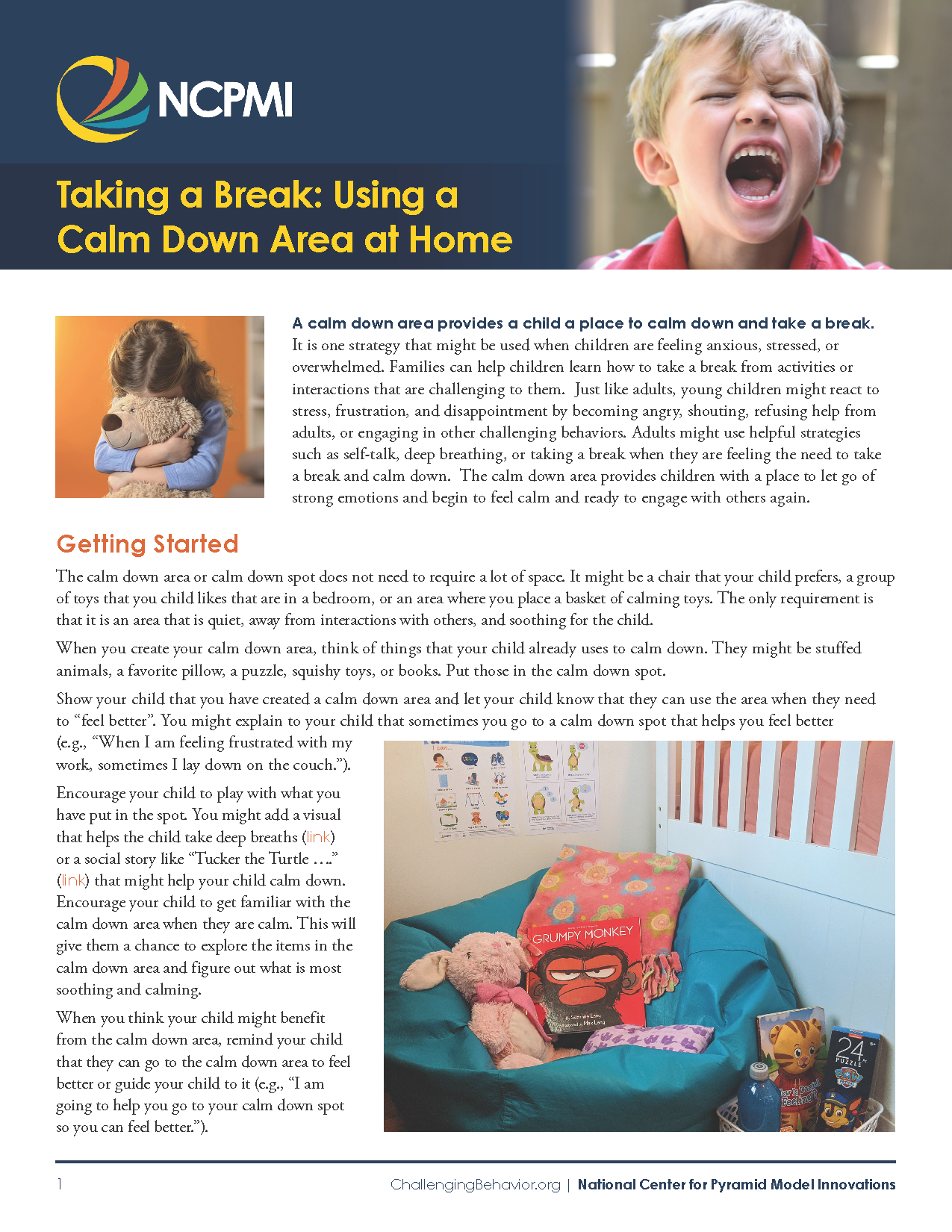
This resource includes instructions and tips for families on how to create a calm down area at home.

This resource includes instructions and tips for families on how to create a calm down area at home.


(Técnica de la tortuga) Turtle technique cards for teaching in Spanish

Caregivers can use the strategies in the infographic to provide infants with predictability in their day, and safety in relationships- all to support healthy attachment. Infants rely on the adults in their lives to read their cues, and help them to regulate as they adapt to their world. Responsive and positive interactions between infants and their caregivers help to build a strong attachment relationship. Positive attachment relationships support healthy brain development, and set babies up for success to learn about their emotions and build relationships as they grow into toddlers and preschoolers.

Caregivers can use the strategies in the infographic to provide infants with predictability in their day, and safety in relationships- all to support healthy attachment. Infants rely on the adults in their lives to read their cues, and help them to regulate as they adapt to their world. Responsive and positive interactions between infants and their caregivers help to build a strong attachment relationship. Positive attachment relationships support healthy brain development, and set babies up for success to learn about their emotions and build relationships as they grow into toddlers and preschoolers.

Toddlers experience big emotions as they learn to make meaning of their world and communicate their needs. Toddlers look to their primary caregivers to let them what they are experiencing is okay. Caregivers can use the strategies included in this infographic to provide toddlers with predictability in their day, safety in relationships, meaning to their experiences and emotions, and begin to build their problem-solving skills.
The translation of this document was performed by a third party. NCPMI makes no guarantees as to the accuracy of the translation.

Toddlers experience big emotions as they learn to make meaning of their world and communicate their needs. Toddlers look to their primary caregivers to let them what they are experiencing is okay. Caregivers can use the strategies included in this infographic to provide toddlers with predictability in their day, safety in relationships, meaning to their experiences and emotions, and begin to build their problem-solving skills.

Toddlers experience big emotions as they learn to make meaning of their world and communicate their needs. Toddlers look to their primary caregivers to let them what they are experiencing is okay. Caregivers can use the strategies included in this infographic to provide toddlers with predictability in their day, safety in relationships, meaning to their experiences and emotions, and begin to build their problem-solving skills.

Toddlers experience big emotions as they learn to make meaning of their world and communicate their needs. Toddlers look to their primary caregivers to let them what they are experiencing is okay. Caregivers can use the strategies included in this infographic to provide toddlers with predictability in their day, safety in relationships, meaning to their experiences and emotions, and begin to build their problem-solving skills.
The translation of this document was performed by a third party. NCPMI makes no guarantees as to the accuracy of the translation.

Toddlers experience big emotions as they learn to make meaning of their world and communicate their needs. Toddlers look to their primary caregivers to let them what they are experiencing is okay. Caregivers can use the strategies included in this infographic to provide toddlers with predictability in their day, safety in relationships, meaning to their experiences and emotions, and begin to build their problem-solving skills.
The translation of this document was performed by a third party. NCPMI makes no guarantees as to the accuracy of the translation.
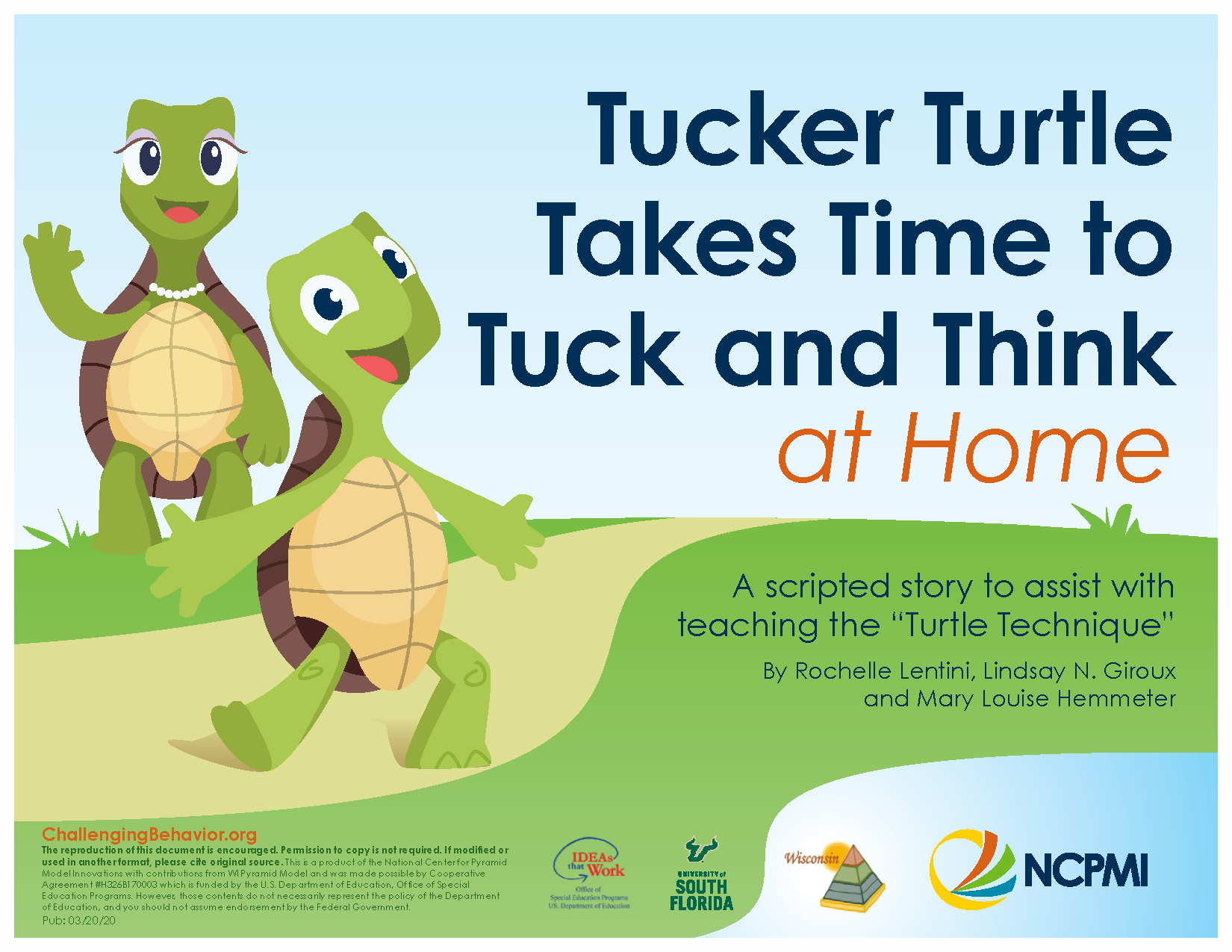
Tucker the Turtle provides a scripted story to teach young children how to calm down when they have strong feelings by tucking into their shell and taking deep breaths. The story also includes visuals to help children learn how to use the strategy.

Tucker the Turtle provides a scripted story to teach young children how to calm down when they have strong feelings by tucking into their shell and taking deep breaths. The story also includes visuals to help children learn how to use the strategy.

Tucker the Turtle provides a scripted story to teach young children how to calm down when they have strong feelings by tucking into their shell and taking deep breaths. The story also includes visuals to help children learn how to use the strategy.

Scripted Stories for Social Situations help children understand social interactions, situations, expectations, social cues, the script of unfamiliar activities, and/or social rules.

Scripted Stories for Social Situations help children understand social interactions, situations, expectations, social cues, the script of unfamiliar activities, and/or social rules.

Scripted Stories for Social Situations help children understand social interactions, situations, expectations, social cues, the script of unfamiliar activities, and/or social rules.

Scripted Stories for Social Situations help children understand social interactions, situations, expectations, social cues, the script of unfamiliar activities, and/or social rules.

The Backpack Connection Series was created by TACSEI to provide a way for teachers and parents/caregivers to work together to help young children develop social emotional skills and reduce challenging behavior. Teachers may choose to send a handout home in each child’s backpack when a new strategy or skill is introduced to the class.

The Backpack Connection Series was created by TACSEI to provide a way for teachers and parents/caregivers to work together to help young children develop social emotional skills and reduce challenging behavior. Teachers may choose to send a handout home in each child’s backpack when a new strategy or skill is introduced to the class.

The Backpack Connection Series was created by TACSEI to provide a way for teachers and parents/caregivers to work together to help young children develop social emotional skills and reduce challenging behavior. Teachers may choose to send a handout home in each child’s backpack when a new strategy or skill is introduced to the class.

The Backpack Connection Series was created by TACSEI to provide a way for teachers and parents/caregivers to work together to help young children develop social emotional skills and reduce challenging behavior. Teachers may choose to send a handout home in each child’s backpack when a new strategy or skill is introduced to the class.

The Backpack Connection Series was created by TACSEI to provide a way for teachers and parents/caregivers to work together to help young children develop social emotional skills and reduce challenging behavior. Teachers may choose to send a handout home in each child’s backpack when a new strategy or skill is introduced to the class.

The Backpack Connection Series was created by TACSEI to provide a way for teachers and parents/caregivers to work together to help young children develop social emotional skills and reduce challenging behavior. Teachers may choose to send a handout home in each child’s backpack when a new strategy or skill is introduced to the class.

The Backpack Connection Series was created by TACSEI to provide a way for teachers and parents/caregivers to work together to help young children develop social emotional skills and reduce challenging behavior. Teachers may choose to send a handout home in each child’s backpack when a new strategy or skill is introduced to the class.

The Backpack Connection Series was created by TACSEI to provide a way for teachers and parents/caregivers to work together to help young children develop social emotional skills and reduce challenging behavior. Teachers may choose to send a handout home in each child’s backpack when a new strategy or skill is introduced to the class.

The Backpack Connection Series was created by TACSEI to provide a way for teachers and parents/caregivers to work together to help young children develop social emotional skills and reduce challenging behavior. Teachers may choose to send a handout home in each child’s backpack when a new strategy or skill is introduced to the class.

The Backpack Connection Series was created by TACSEI to provide a way for teachers and parents/caregivers to work together to help young children develop social emotional skills and reduce challenging behavior. Teachers may choose to send a handout home in each child’s backpack when a new strategy or skill is introduced to the class.

The Backpack Connection Series was created by TACSEI to provide a way for teachers and parents/caregivers to work together to help young children develop social emotional skills and reduce challenging behavior. Teachers may choose to send a handout home in each child’s backpack when a new strategy or skill is introduced to the class.

The Backpack Connection Series was created by TACSEI to provide a way for teachers and parents/caregivers to work together to help young children develop social emotional skills and reduce challenging behavior. Teachers may choose to send a handout home in each child’s backpack when a new strategy or skill is introduced to the class.

The Backpack Connection Series was created by TACSEI to provide a way for teachers and parents/caregivers to work together to help young children develop social emotional skills and reduce challenging behavior. Teachers may choose to send a handout home in each child’s backpack when a new strategy or skill is introduced to the class.

The Backpack Connection Series was created by TACSEI to provide a way for teachers and parents/caregivers to work together to help young children develop social emotional skills and reduce challenging behavior. Teachers may choose to send a handout home in each child’s backpack when a new strategy or skill is introduced to the class.

The Backpack Connection Series was created by TACSEI to provide a way for teachers and parents/caregivers to work together to help young children develop social emotional skills and reduce challenging behavior. Teachers may choose to send a handout home in each child’s backpack when a new strategy or skill is introduced to the class.

The Backpack Connection Series was created by TACSEI to provide a way for teachers and parents/caregivers to work together to help young children develop social emotional skills and reduce challenging behavior. Teachers may choose to send a handout home in each child’s backpack when a new strategy or skill is introduced to the class.

The Backpack Connection Series was created by TACSEI to provide a way for teachers and parents/caregivers to work together to help young children develop social emotional skills and reduce challenging behavior. Teachers may choose to send a handout home in each child’s backpack when a new strategy or skill is introduced to the class.

The Backpack Connection Series was created by TACSEI to provide a way for teachers and parents/caregivers to work together to help young children develop social emotional skills and reduce challenging behavior. Teachers may choose to send a handout home in each child’s backpack when a new strategy or skill is introduced to the class.

The Feeling Faces assist children with understanding their feelings and the feelings of others. It is important to teach children words to use to express feelings in replace of the use of challenging behavior. The feeling faces that follow can be used in a variety of ways to help children learn social emotional skills around use of emotional literacy and vocabulary.

The Feeling Faces assist children with understanding their feelings and the feelings of others. It is important to teach children words to use to express feelings in replace of the use of challenging behavior. The feeling faces that follow can be used in a variety of ways to help children learn social emotional skills around use of emotional literacy and vocabulary.

The Feeling Faces assist children with understanding their feelings and the feelings of others. It is important to teach children words to use to express feelings in replace of the use of challenging behavior. The feeling faces that follow can be used in a variety of ways to help children learn social emotional skills around use of emotional literacy and vocabulary.

The Feeling Faces assist children with understanding their feelings and the feelings of others. It is important to teach children words to use to express feelings in replace of the use of challenging behavior. The feeling faces that follow can be used in a variety of ways to help children learn social emotional skills around use of emotional literacy and vocabulary.

The Feeling Faces assist children with understanding their feelings and the feelings of others. It is important to teach children words to use to express feelings in replace of the use of challenging behavior. The feeling faces that follow can be used in a variety of ways to help children learn social emotional skills around use of emotional literacy and vocabulary.

The Feeling Faces assist children with understanding their feelings and the feelings of others. It is important to teach children words to use to express feelings in replace of the use of challenging behavior. The feeling faces that follow can be used in a variety of ways to help children learn social emotional skills around use of emotional literacy and vocabulary.

Print and laminate these placemats for a fun way to embed emotional literacy practice at home or at school. Each mat provides a blank face paired with a feeling word and emoticon that children can use to model the feeling faces. Use the mats to make feeling faces out of play dough or other sand/clay material. Laminated mats can also be used with dry erase markers for easy wipe off when play is done.

The Feeling Faces assist children with understanding their feelings and the feelings of others. It is important to teach children words to use to express feelings in replace of the use of challenging behavior. The feeling faces that follow can be used in a variety of ways to help children learn social emotional skills around use of emotional literacy and vocabulary.

The Feeling Faces assist children with understanding their feelings and the feelings of others. It is important to teach children words to use to express feelings in replace of the use of challenging behavior. The feeling faces that follow can be used in a variety of ways to help children learn social emotional skills around use of emotional literacy and vocabulary.

The Feeling Faces assist children with understanding their feelings and the feelings of others. It is important to teach children words to use to express feelings in replace of the use of challenging behavior. The feeling faces that follow can be used in a variety of ways to help children learn social emotional skills around use of emotional literacy and vocabulary.

The Feeling Faces assist children with understanding their feelings and the feelings of others. It is important to teach children words to use to express feelings in replace of the use of challenging behavior. The feeling faces that follow can be used in a variety of ways to help children learn social emotional skills around use of emotional literacy and vocabulary.

The Feeling Faces assist children with understanding their feelings and the feelings of others. It is important to teach children words to use to express feelings in replace of the use of challenging behavior. The feeling faces that follow can be used in a variety of ways to help children learn social emotional skills around use of emotional literacy and vocabulary.

The Feeling Faces assist children with understanding their feelings and the feelings of others. It is important to teach children words to use to express feelings in replace of the use of challenging behavior. The feeling faces that follow can be used in a variety of ways to help children learn social emotional skills around use of emotional literacy and vocabulary.

The Feeling Faces assist children with understanding their feelings and the feelings of others. It is important to teach children words to use to express feelings in replace of the use of challenging behavior. The feeling faces that follow can be used in a variety of ways to help children learn social emotional skills around use of emotional literacy and vocabulary.

The Feeling Faces assist children with understanding their feelings and the feelings of others. It is important to teach children words to use to express feelings in replace of the use of challenging behavior. The feeling faces that follow can be used in a variety of ways to help children learn social emotional skills around use of emotional literacy and vocabulary. Includes introduction in Spanish and visual in English and Spanish.

The Feeling Faces assist children with understanding their feelings and the feelings of others. It is important to teach children words to use to express feelings in replace of the use of challenging behavior. The feeling faces that follow can be used in a variety of ways to help children learn social emotional skills around use of emotional literacy and vocabulary.

Here are tips and ideas for helping children identify emotions when your face, your most expressive feature, is covered by a mask. Use these strategies to let children know that behind the mask, a kind and warm expression is still there!

Understanding feelings is an important part of a child’s social emotional development. Babies and toddlers experience feelings just like you do, and know when you are feeling happy or down as well. When you use words to describe emotions, share in their good feelings, and comfort them when they feel sad or overwhelmed, young children are learning important social emotional skills.

Understanding feelings is an important part of a child’s social emotional development. Babies and toddlers experience feelings just like you do, and know when you are feeling happy or down as well. When you use words to describe emotions, share in their good feelings, and comfort them when they feel sad or overwhelmed, young children are learning important social emotional skills.

Young children deal with many of the same emotions adults do. Children get angry, sad, frustrated, nervous, happy, or embarrassed, but they often do not have the words to talk about how they are feeling. Instead, they sometimes act out these emotions in very physical and inappropriate ways. This four-page handout describes specific steps and strategies adults can use to help children express themselves in ways that are appropriate.

Young children deal with many of the same emotions adults do. Children get angry, sad, frustrated, nervous, happy, or embarrassed, but they often do not have the words to talk about how they are feeling. Instead, they sometimes act out these emotions in very physical and inappropriate ways. This four-page handout describes specific steps and strategies adults can use to help children express themselves in ways that are appropriate.

Letter addressed to families announcing the use of the solution kit at the program.

Letter addressed to families announcing the use of the solution kit at the program.

Letter addressed to families announcing the use of the solution kit at the program.

Letter addressed to families announcing the use of the solution kit at the program.
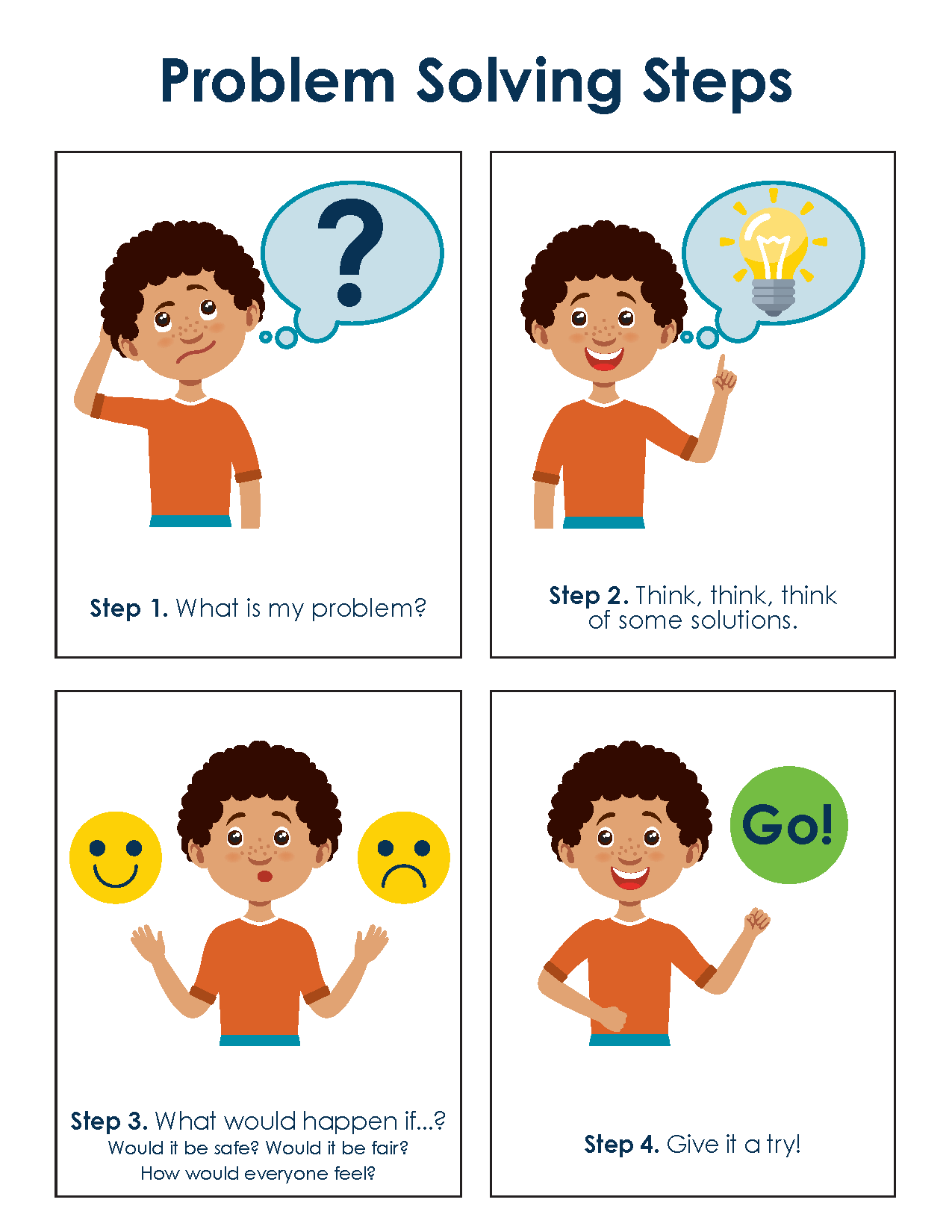
Problem solving steps strategies and poster. Includes boy and girl versions.

Problem solving steps strategies and poster. Includes boy and girl versions.

Problem solving steps strategies and poster. Includes boy and girl versions.

Problem solving steps strategies and poster. Includes boy and girl versions.

Use the solution kit cards as prompts to assist in problem-solving.

Use the solution kit cards as prompts to assist in problem-solving.

Use the solution kit cards as prompts to assist in problem-solving.

Use the solution kit cards as prompts to assist in problem-solving.

Use this scripted story to help children find a solution to her problem.

Use this scripted story to help children find a solution to her problem.

Use this scripted story to help children find a solution to her problem.
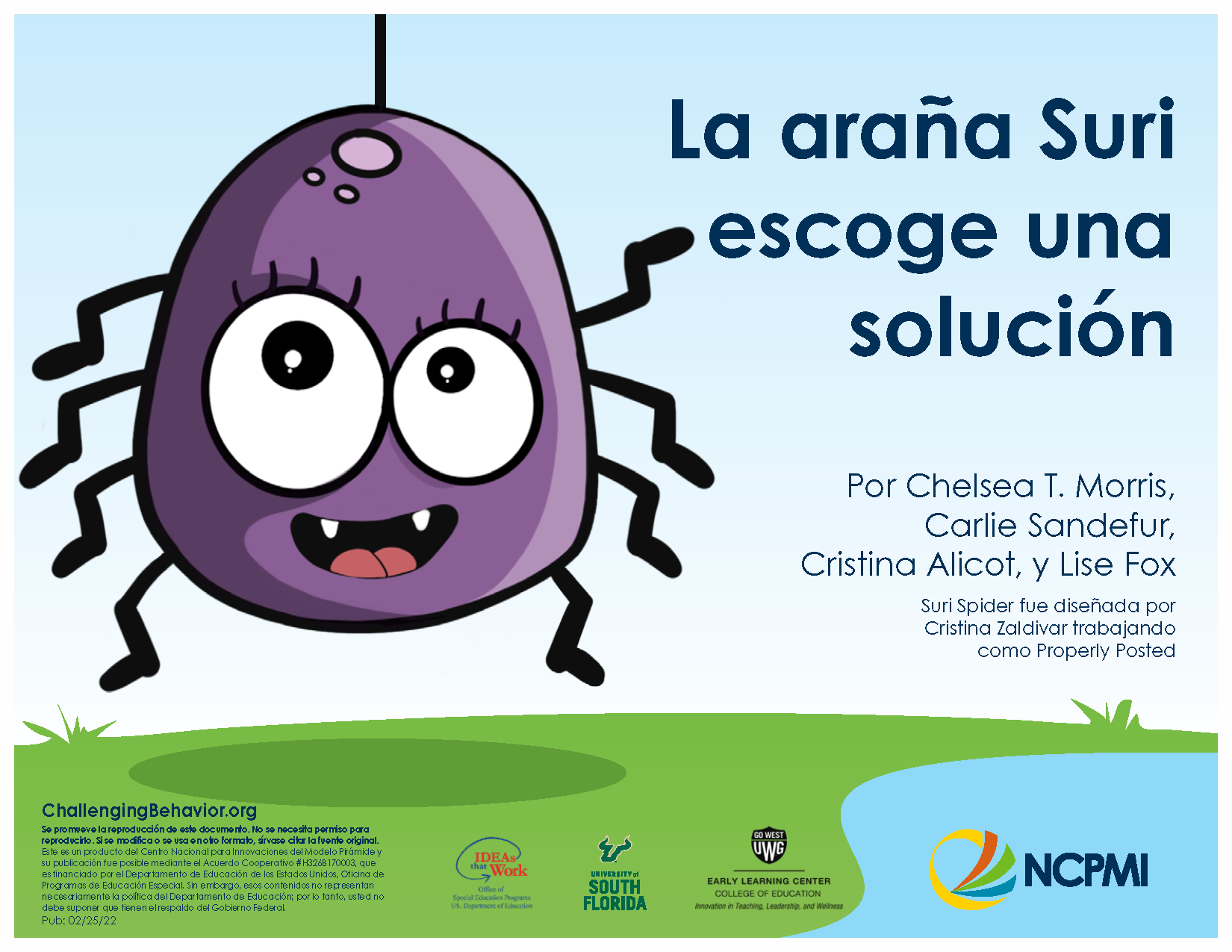
Use this scripted story to help children find a solution to her problem.

Scripted story to help children understand the steps to problem solving. Includes problem scenario cards to help children practice finding a solution to common social problems.

Scripted story to help children understand the steps to problem solving. Includes problem scenario cards to help children practice finding a solution to common social problems.

Scripted story to help children understand the steps to problem solving. Includes problem scenario cards to help children practice finding a solution to common social problems.

Scripted story to help children understand the steps to problem solving. Includes problem scenario cards to help children practice finding a solution to common social problems.
Scripted Stories for Social Situations are short PowerPoint presentations consisting of a mixture of words and pictures that provide specific information to a child about social situations such as going to preschool, sitting in circle time, staying safe and using words. When children are given information that helps them understand expectations, their problem behavior within that situation is reduced or minimized. These stories provide examples of how scripted stories are worded and illustrated for a child. Teachers and families should modify the story to be meaningful for the child they are supporting and the unique context of the social situation.
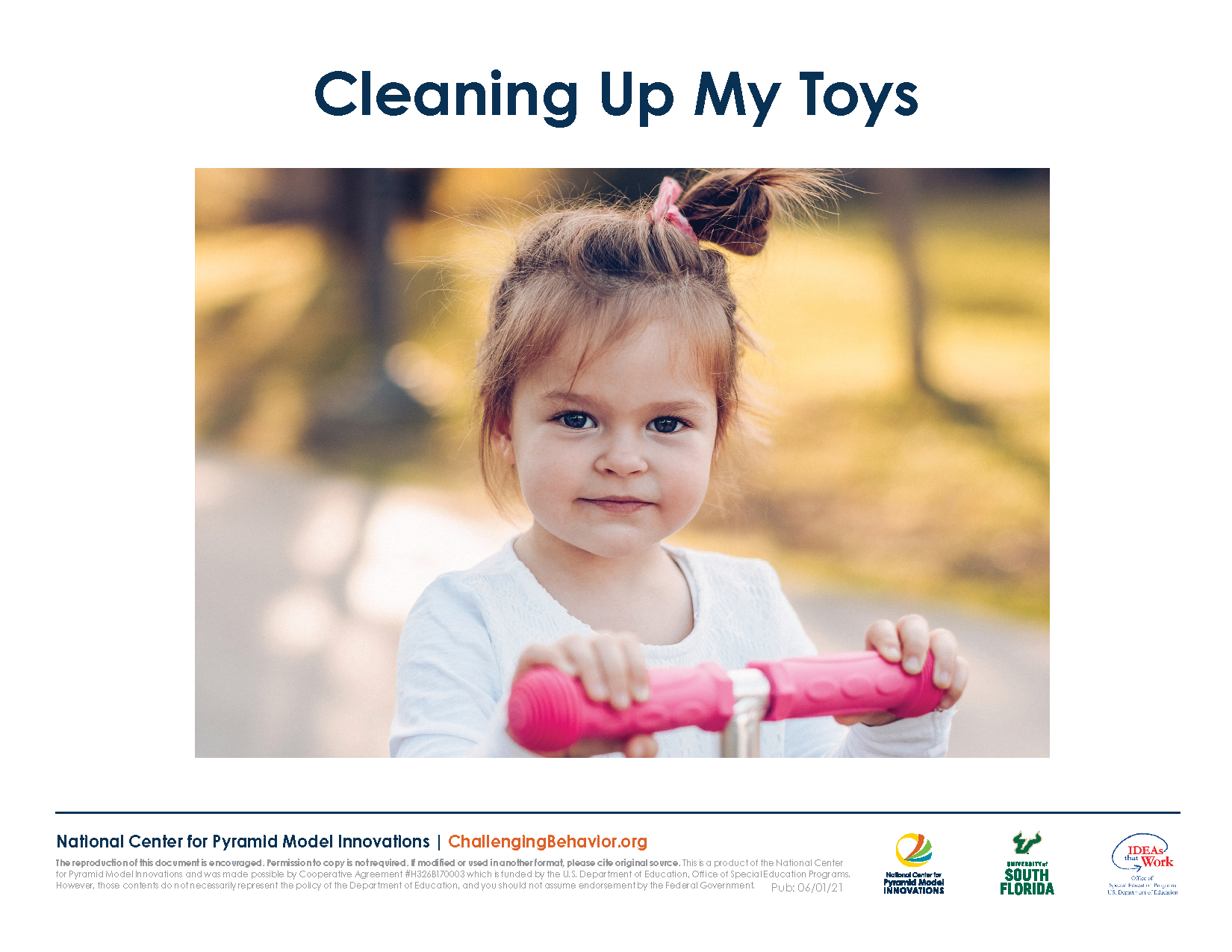
This sample scripted story shows a child learning the steps to cleaning up toys.

This sample scripted story shows a child learning the steps to cleaning up toys.

This tip sheet highlights the important considerations for making a scripted story about cleaning up toys.

This tip sheet highlights the important considerations for making a scripted story about cleaning up toys.

Use this scripted story to teach a child about the expectations and rules associated with going to school.

Use this scripted story to teach a child about the expectations and rules associated with going to school.

This sample scripted story shows a child learning the steps to brushing their teeth.

This sample scripted story shows a child learning the steps to brushing their teeth.
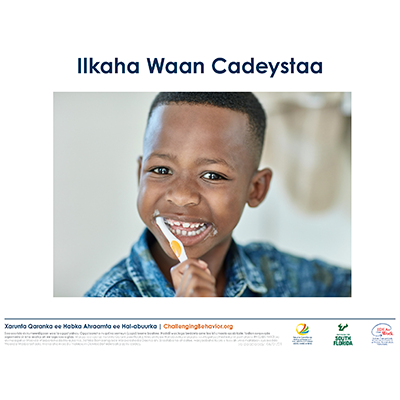
This sample scripted story shows a child learning the steps to brushing their teeth.

This sample scripted story shows a child learning the steps to brushing their teeth.

This tip sheet highlights the important considerations for making a scripted story about brushing teeth.
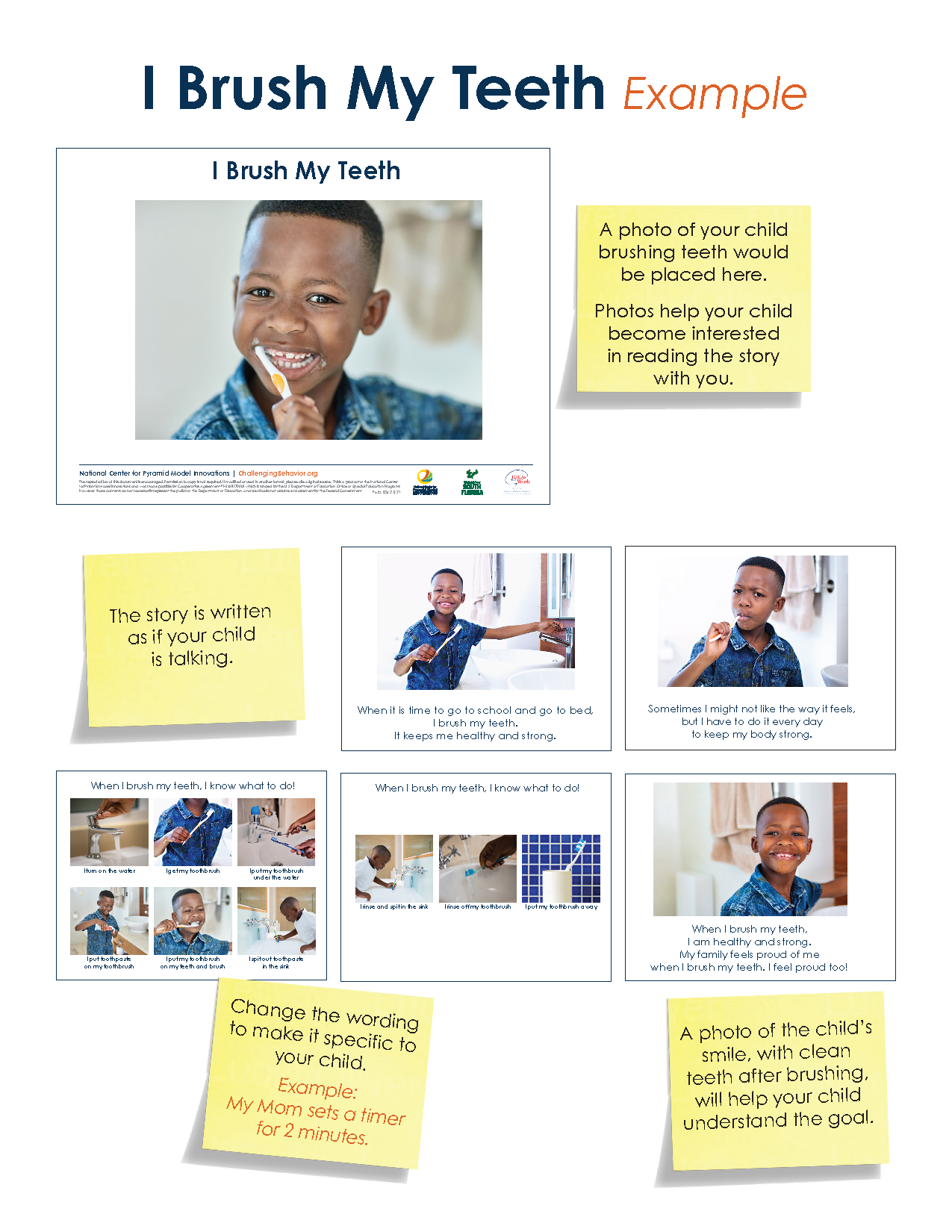
This tip sheet highlights the important considerations for making a scripted story about brushing teeth.

Scripted Stories for Social Situations help children understand social interactions, situations, expectations, social cues, the script of unfamiliar activities, and/or social rules.

Scripted Stories for Social Situations help children understand social interactions, situations, expectations, social cues, the script of unfamiliar activities, and/or social rules.

Scripted Stories for Social Situations help children understand social interactions, situations, expectations, social cues, the script of unfamiliar activities, and/or social rules.

Scripted Stories for Social Situations help children understand social interactions, situations, expectations, social cues, the script of unfamiliar activities, and/or social rules.

Use this scripted story to teach a child about the why and how to wash hands.

Use this scripted story to teach a child about the why and how to wash hands.

This sample scripted story shows how families might teach a child about expectations and family rules.

This sample scripted story shows how families might teach a child about expectations and family rules.

Scripted Stories for Social Situations help children understand social interactions, situations, expectations, social cues, the script of unfamiliar activities, and/or social rules.

Scripted Stories for Social Situations help children understand social interactions, situations, expectations, social cues, the script of unfamiliar activities, and/or social rules.

Scripted Stories for Social Situations help children understand social interactions, situations, expectations, social cues, the script of unfamiliar activities, and/or social rules.

Scripted Stories for Social Situations help children understand social interactions, situations, expectations, social cues, the script of unfamiliar activities, and/or social rules.

Scripted Stories for Social Situations help children understand social interactions, situations, expectations, social cues, the script of unfamiliar activities, and/or social rules.

Scripted Stories for Social Situations help children understand social interactions, situations, expectations, social cues, the script of unfamiliar activities, and/or social rules.

Scripted Stories for Social Situations help children understand social interactions, situations, expectations, social cues, the script of unfamiliar activities, and/or social rules.

Scripted Stories for Social Situations help children understand social interactions, situations, expectations, social cues, the script of unfamiliar activities, and/or social rules.

This tipsheet contains suggestions on how to develop and use scripted stories at home.
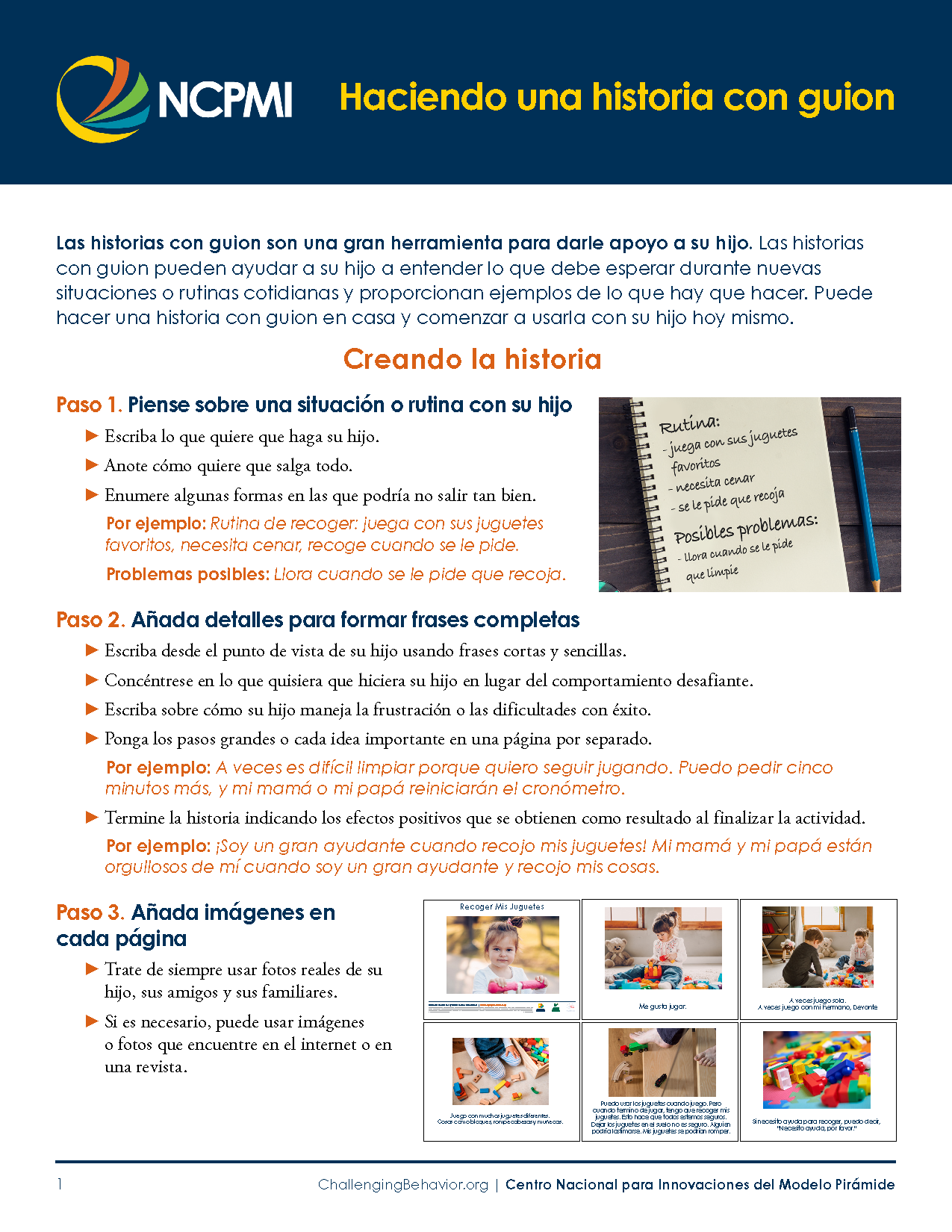
This tipsheet contains suggestions on how to develop and use scripted stories at home.

Use this scripted story to help children find a solution to her problem.

Use this scripted story to help children find a solution to her problem.

Use this scripted story to help children find a solution to her problem.

Use this scripted story to help children find a solution to her problem.

Tucker the Turtle provides a scripted story to teach young children how to calm down when they have strong feelings by tucking into their shell and taking deep breaths. The story also includes visuals to help children learn how to use the strategy.

Tucker the Turtle provides a scripted story to teach young children how to calm down when they have strong feelings by tucking into their shell and taking deep breaths. The story also includes visuals to help children learn how to use the strategy.

Tucker the Turtle provides a scripted story to teach young children how to calm down when they have strong feelings by tucking into their shell and taking deep breaths. The story also includes visuals to help children learn how to use the strategy.

Scripted story to help children understand the steps to problem solving. Includes problem scenario cards to help children practice finding a solution to common social problems.

Scripted story to help children understand the steps to problem solving. Includes problem scenario cards to help children practice finding a solution to common social problems.

Scripted story to help children understand the steps to problem solving. Includes problem scenario cards to help children practice finding a solution to common social problems.

Scripted story to help children understand the steps to problem solving. Includes problem scenario cards to help children practice finding a solution to common social problems.

This scripted story helps to explain to children the how, why, and when of wearing face masks.

This scripted story helps to explain to children the how, why, and when of wearing face masks.

Scripted story to help families explain to children why they have to stay home during emergency or disaster situations.

Scripted story to help families explain to children why they have to stay home during emergency or disaster situations.
Building Relationships


Think of all the ways you make connections with children as deposits into their “emotional piggy bank.” Playing, giving time and attention, and showing warmth and affection are just a few ways we can make deposits. Fill in the coins on the worksheet with ideas of how you will build responsive relationships with children.? Being purposeful and consistent in the way we create nurturing and responsive relationships with children is the foundation for social-emotional learning.

Think of all the ways you make connections with children as deposits into their “emotional piggy bank.” Playing, giving time and attention, and showing warmth and affection are just a few ways we can make deposits. Fill in the coins on the worksheet with ideas of how you will build responsive relationships with children.? Being purposeful and consistent in the way we create nurturing and responsive relationships with children is the foundation for social-emotional learning.

Providing positive encouragement is a powerful practice for helping children meet behavior expectations. This fact sheet provides ideas for how caregivers can deliver positive encouragement.

Providing positive encouragement is a powerful practice for helping children meet behavior expectations. This fact sheet provides ideas for how caregivers can deliver positive encouragement.

Providing positive encouragement is a powerful practice for helping children meet behavior expectations. This fact sheet provides ideas for how caregivers can deliver positive encouragement.

This webinar introduced 10 dimensions of belonging and explores how Pyramid Model programs, providers, and policies can progress beyond family engagement. Presenters will share practical examples for designing and cultivating environments and experiences that celebrate families’ strengths and value their essential role in the community, fostering a meaningful quality of life for all.

This resource provides three steps for teachers to follow when they have a challenging encounter with a family to get things back on track in order to provide the best care for the child and the family.

Infographic about various communication strategies for early childhood programs to communicate with families.

With children learning at home, our connections with families are so important. These tips will
help you be focused and responsive during those calls or virtual meetings.

Tip Sheet on various communication strategies for early childhood programs and teachers to communicate with families.

This handout includes important considerations for including families at every step of the PTR-YC process.

Is the Pyramid Model a framework that can be used in programs serving indigenous children and their families? What changes need to be made to ensure a fit with the culture of tribes and families served by those programs? Join us for a discussion from two programs, Cook Inlet Native Head Start in Alaska and Zaasijiwan Head Start in Wisconsin, to learn more about their Pyramid Model implementation and outcomes.

Programs can use this form to gather information from families as to the impact from the pandemic and best ways to support the child and family.
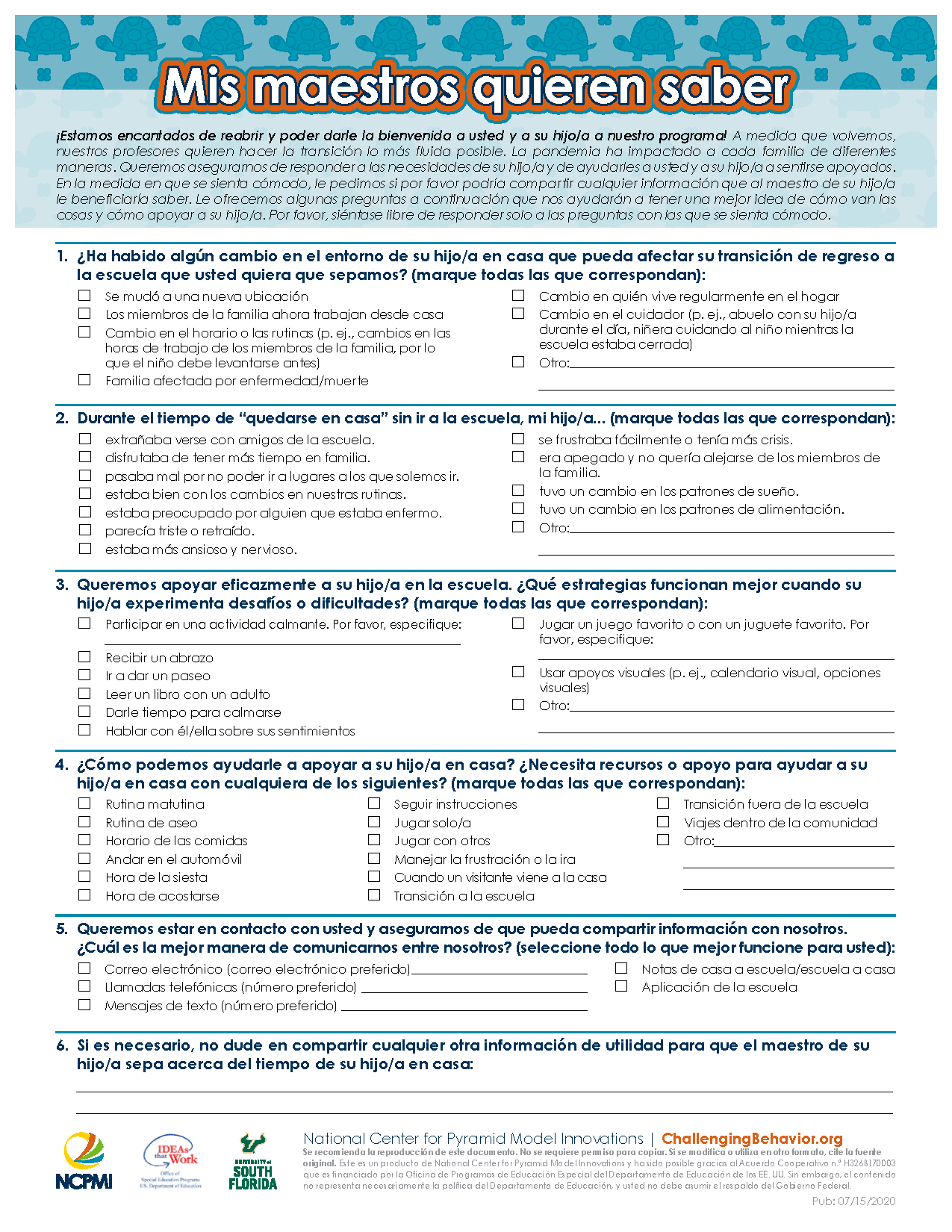
Programs can use this form to gather information from families as to the impact from the pandemic and best ways to support the child and family.

Programs can use this form to gather information from families as to the impact from the pandemic and best ways to support the child and family.

This brief provides practitioners with practical strategies for building relationships and collaborating with families from racially and ethnically diverse cultural backgrounds. It identifies common challenges and offers strategies for addressing them.

Are you providing early intervention or preschool services using distance technology? Do you have questions about how you can support families as they help their children with learning activities or conducting intervention within routines? NCPMI faculty share ideas on checking in with families, how to respond to difficult questions, and resources that might be shared.

This fact sheet provides guidance for supporting children and families during difficult circumstances (e.g., national protests, community violence).

Dos and Don?ts for talking with families about their child’s problem behavior. This is a one-page handout.

As early childhood programs work on re-opening after a long closure, they can use these online communication and phone scripts to help guide your conversations with families.
Family Handout Collections
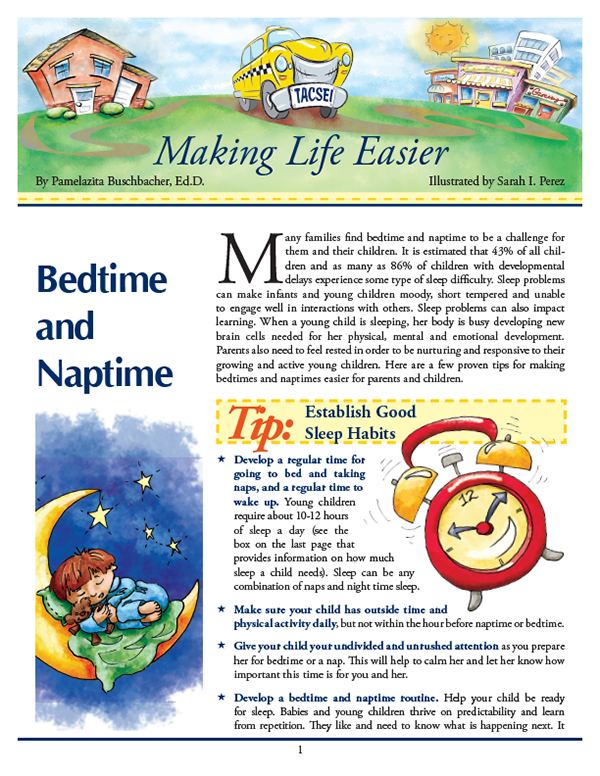
Many families find bedtime and naptime to be a challenge for them and their children. Sleep problems can make infants and young children moody, short tempered and unable to engage well in interactions with others. Sleep problems can also impact learning. Parents also need to feel rested in order to be nurturing and responsive to their growing and active young children. This first installment of the?Making Life Easier’series provides a few proven tips for making bedtimes and naptimes easier for both parents and children. Also includes a handy tip card for quick reference.

Many families find bedtime and naptime to be a challenge for them and their children. Sleep problems can make infants and young children moody, short tempered and unable to engage well in interactions with others. Sleep problems can also impact learning. Parents also need to feel rested in order to be nurturing and responsive to their growing and active young children. This first installment of the?Making Life Easier’series provides a few proven tips for making bedtimes and naptimes easier for both parents and children. Also includes a handy tip card for quick reference. Translation provided by WestEd (https://cainclusion.org).

Many families find bedtime and naptime to be a challenge for them and their children. Sleep problems can make infants and young children moody, short tempered and unable to engage well in interactions with others. Sleep problems can also impact learning. Parents also need to feel rested in order to be nurturing and responsive to their growing and active young children. This first installment of the?Making Life Easier’series provides a few proven tips for making bedtimes and naptimes easier for both parents and children. Also includes a handy tip card for quick reference. Translation provided by WestEd (https://cainclusion.org).

For many families, changing a child’s diaper can be a major battle. This routine is usually not as predictable as other activities, is often unpleasant for adults and not an event that the young child enjoys. While it can be challenging, it is also an opportunity to build a positive, nurturing and responsive relationship with your child. This installment of the Making Life Easier series provides several proven strategies to help make diapering a positive and relationship building experience for you both. Also includes a handy tip card for quick reference.

For many families, changing a child’s diaper can be a major battle. This routine is usually not as predictable as other activities, is often unpleasant for adults and not an event that the young child enjoys. While it can be challenging, it is also an opportunity to build a positive, nurturing and responsive relationship with your child. This installment of the Making Life Easier series provides several proven strategies to help make diapering a positive and relationship building experience for you both. Also includes a handy tip card for quick reference. Translation provided by WestEd (https://cainclusion.org).

For many families, changing a child’s diaper can be a major battle. This routine is usually not as predictable as other activities, is often unpleasant for adults and not an event that the young child enjoys. While it can be challenging, it is also an opportunity to build a positive, nurturing and responsive relationship with your child. This installment of the Making Life Easier series provides several proven strategies to help make diapering a positive and relationship building experience for you both. Also includes a handy tip card for quick reference. Translation provided by WestEd (https://cainclusion.org).

Doctor and dentist visits can be very stressful for young children. Routine check-ups can cause anxiety, fear and distress in toddlers and preschoolers. In this Making Life Easier issue, adults are provided with tips to prepare the child for these appointments and make visits to the doctor or dentist less stressful for everyone.

While the holiday season is filled with enjoyable activities, events and traditions, it can also be a hectic and stressful time. Travel, shopping, loud music, bright lights, unfamiliar food, and busy schedules can turn typical routines upside down! The disruption to routine can be particularly difficult for children who depend on routine and predictability to engage in appropriate behavior.

Running errands (e.g., going to the store, bank, etc.) is one of those essential household routines that all families experience. It is often thought of as a ?maintenance? activity that is necessary for the family, but not enjoyable for young children. While there can be huge benefits in taking your young child along, running errands can be extremely difficult if the child has challenging behavior. Still, there are several steps you can take to help you and your child get the most out of these outings. Also includes a handy tip card for quick reference.

Running errands (e.g., going to the store, bank, etc.) is one of those essential household routines that all families experience. It is often thought of as a ?maintenance? activity that is necessary for the family, but not enjoyable for young children. While there can be huge benefits in taking your young child along, running errands can be extremely difficult if the child has challenging behavior. Still, there are several steps you can take to help you and your child get the most out of these outings. Also includes a handy tip card for quick reference. Translation provided by WestEd (https://cainclusion.org).

Running errands (e.g., going to the store, bank, etc.) is one of those essential household routines that all families experience. It is often thought of as a ?maintenance? activity that is necessary for the family, but not enjoyable for young children. While there can be huge benefits in taking your young child along, running errands can be extremely difficult if the child has challenging behavior. Still, there are several steps you can take to help you and your child get the most out of these outings. Also includes a handy tip card for quick reference. Translation provided by WestEd (https://cainclusion.org).
The Backpack Connection Series was created by TACSEI to provide a way for teachers and parents/caregivers to work together to help young children develop social emotional skills and reduce challenging behavior. Teachers may choose to send a handout home in each child’s backpack when a new strategy or skill is introduced to the class. Each Backpack Connection handout provides information that helps parents stay informed about what their child is learning at school and specific ideas on how to use the strategy or skill at home. This series was developed in collaboration with Pyramid Plus: The Colorado Center for Social Emotional Competence and Inclusion and Bal Swan Children’s Center in Broomfield, Colorado.
The Backpack Connection Series includes handouts in four categories: Addressing Behavior, Emotions, Routines and Schedules, and Social Skills.
Other Languages
Looking for Backpack Connection or other Family Materials in Spanish or Chinese? Our resources have been translated. Click below to explore additional materials on cainclusion.org.

The Backpack Connection Series was created by TACSEI to provide a way for teachers and parents/caregivers to work together to help young children develop social emotional skills and reduce challenging behavior. Teachers may choose to send a handout home in each child’s backpack when a new strategy or skill is introduced to the class.

The Backpack Connection Series was created by TACSEI to provide a way for teachers and parents/caregivers to work together to help young children develop social emotional skills and reduce challenging behavior. Teachers may choose to send a handout home in each child’s backpack when a new strategy or skill is introduced to the class.

The Backpack Connection Series was created by TACSEI to provide a way for teachers and parents/caregivers to work together to help young children develop social emotional skills and reduce challenging behavior. Teachers may choose to send a handout home in each child’s backpack when a new strategy or skill is introduced to the class.

The Backpack Connection Series was created by TACSEI to provide a way for teachers and parents/caregivers to work together to help young children develop social emotional skills and reduce challenging behavior. Teachers may choose to send a handout home in each child’s backpack when a new strategy or skill is introduced to the class.

The Backpack Connection Series was created by TACSEI to provide a way for teachers and parents/caregivers to work together to help young children develop social emotional skills and reduce challenging behavior. Teachers may choose to send a handout home in each child’s backpack when a new strategy or skill is introduced to the class.

The Backpack Connection Series was created by TACSEI to provide a way for teachers and parents/caregivers to work together to help young children develop social emotional skills and reduce challenging behavior. Teachers may choose to send a handout home in each child’s backpack when a new strategy or skill is introduced to the class.

The Backpack Connection Series was created by TACSEI to provide a way for teachers and parents/caregivers to work together to help young children develop social emotional skills and reduce challenging behavior. Teachers may choose to send a handout home in each child’s backpack when a new strategy or skill is introduced to the class.

The Backpack Connection Series was created by TACSEI to provide a way for teachers and parents/caregivers to work together to help young children develop social emotional skills and reduce challenging behavior. Teachers may choose to send a handout home in each child’s backpack when a new strategy or skill is introduced to the class.

The Backpack Connection Series was created by TACSEI to provide a way for teachers and parents/caregivers to work together to help young children develop social emotional skills and reduce challenging behavior. Teachers may choose to send a handout home in each child’s backpack when a new strategy or skill is introduced to the class.

The Backpack Connection Series was created by TACSEI to provide a way for teachers and parents/caregivers to work together to help young children develop social emotional skills and reduce challenging behavior. Teachers may choose to send a handout home in each child’s backpack when a new strategy or skill is introduced to the class.

The Backpack Connection Series was created by TACSEI to provide a way for teachers and parents/caregivers to work together to help young children develop social emotional skills and reduce challenging behavior. Teachers may choose to send a handout home in each child’s backpack when a new strategy or skill is introduced to the class.

The Backpack Connection Series was created by TACSEI to provide a way for teachers and parents/caregivers to work together to help young children develop social emotional skills and reduce challenging behavior. Teachers may choose to send a handout home in each child’s backpack when a new strategy or skill is introduced to the class.

The Backpack Connection Series was created by TACSEI to provide a way for teachers and parents/caregivers to work together to help young children develop social emotional skills and reduce challenging behavior. Teachers may choose to send a handout home in each child’s backpack when a new strategy or skill is introduced to the class.

The Backpack Connection Series was created by TACSEI to provide a way for teachers and parents/caregivers to work together to help young children develop social emotional skills and reduce challenging behavior. Teachers may choose to send a handout home in each child’s backpack when a new strategy or skill is introduced to the class.
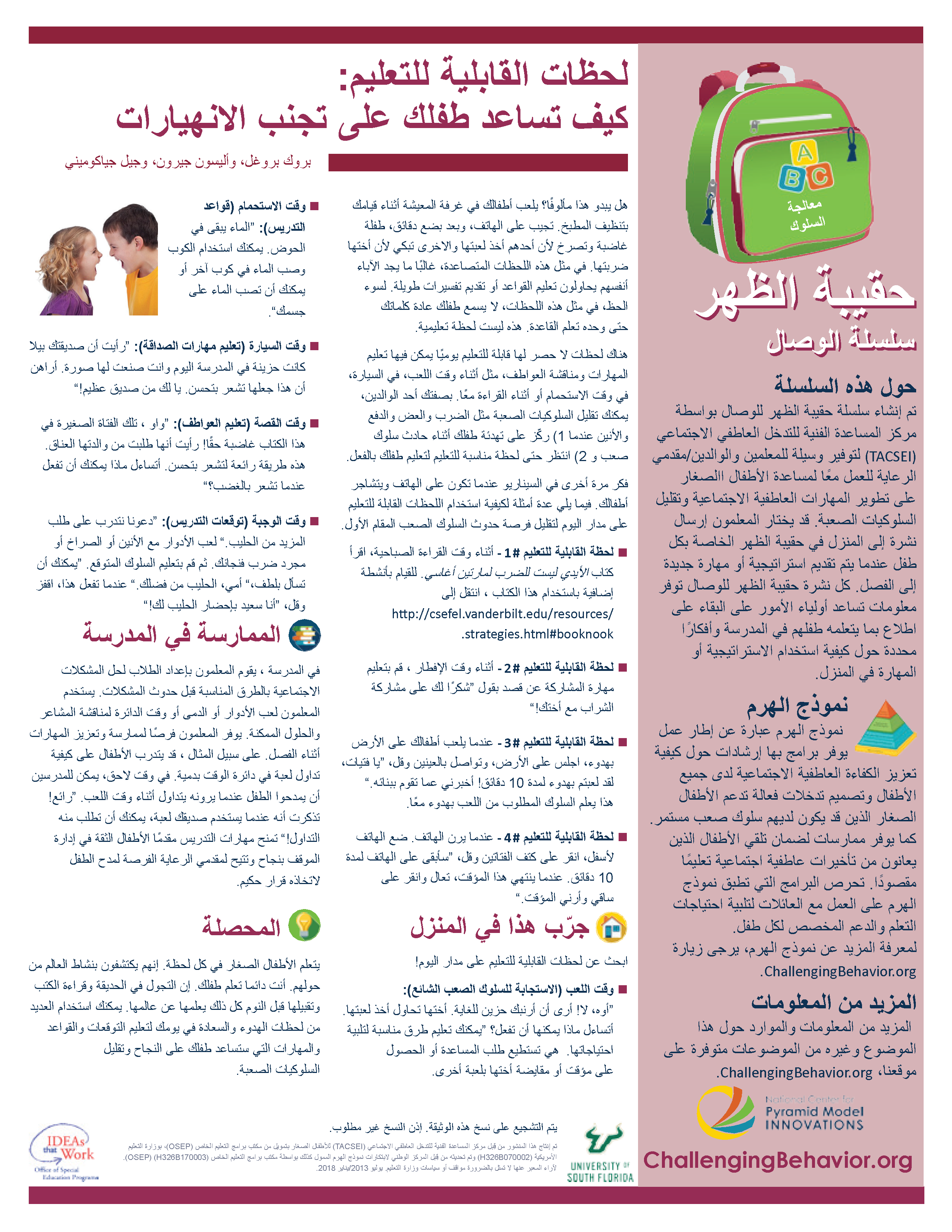
The Backpack Connection Series was created by TACSEI to provide a way for teachers and parents/caregivers to work together to help young children develop social emotional skills and reduce challenging behavior. Teachers may choose to send a handout home in each child’s backpack when a new strategy or skill is introduced to the class.

The Backpack Connection Series was created by TACSEI to provide a way for teachers and parents/caregivers to work together to help young children develop social emotional skills and reduce challenging behavior. Teachers may choose to send a handout home in each child’s backpack when a new strategy or skill is introduced to the class.

The Backpack Connection Series was created by TACSEI to provide a way for teachers and parents/caregivers to work together to help young children develop social emotional skills and reduce challenging behavior. Teachers may choose to send a handout home in each child’s backpack when a new strategy or skill is introduced to the class.

The Backpack Connection Series was created by TACSEI to provide a way for teachers and parents/caregivers to work together to help young children develop social emotional skills and reduce challenging behavior. Teachers may choose to send a handout home in each child’s backpack when a new strategy or skill is introduced to the class.

The Backpack Connection Series was created by TACSEI to provide a way for teachers and parents/caregivers to work together to help young children develop social emotional skills and reduce challenging behavior. Teachers may choose to send a handout home in each child’s backpack when a new strategy or skill is introduced to the class.

The Backpack Connection Series was created by TACSEI to provide a way for teachers and parents/caregivers to work together to help young children develop social emotional skills and reduce challenging behavior. Teachers may choose to send a handout home in each child’s backpack when a new strategy or skill is introduced to the class.

The Backpack Connection Series was created by TACSEI to provide a way for teachers and parents/caregivers to work together to help young children develop social emotional skills and reduce challenging behavior. Teachers may choose to send a handout home in each child’s backpack when a new strategy or skill is introduced to the class.

The Backpack Connection Series was created by TACSEI to provide a way for teachers and parents/caregivers to work together to help young children develop social emotional skills and reduce challenging behavior. Teachers may choose to send a handout home in each child’s backpack when a new strategy or skill is introduced to the class.

The Backpack Connection Series was created by TACSEI to provide a way for teachers and parents/caregivers to work together to help young children develop social emotional skills and reduce challenging behavior. Teachers may choose to send a handout home in each child’s backpack when a new strategy or skill is introduced to the class.

The Backpack Connection Series was created by TACSEI to provide a way for teachers and parents/caregivers to work together to help young children develop social emotional skills and reduce challenging behavior. Teachers may choose to send a handout home in each child’s backpack when a new strategy or skill is introduced to the class.

The Backpack Connection Series was created by TACSEI to provide a way for teachers and parents/caregivers to work together to help young children develop social emotional skills and reduce challenging behavior. Teachers may choose to send a handout home in each child’s backpack when a new strategy or skill is introduced to the class.

The Backpack Connection Series was created by TACSEI to provide a way for teachers and parents/caregivers to work together to help young children develop social emotional skills and reduce challenging behavior. Teachers may choose to send a handout home in each child’s backpack when a new strategy or skill is introduced to the class.

The Backpack Connection Series was created by TACSEI to provide a way for teachers and parents/caregivers to work together to help young children develop social emotional skills and reduce challenging behavior. Teachers may choose to send a handout home in each child’s backpack when a new strategy or skill is introduced to the class.

The Backpack Connection Series was created by TACSEI to provide a way for teachers and parents/caregivers to work together to help young children develop social emotional skills and reduce challenging behavior. Teachers may choose to send a handout home in each child’s backpack when a new strategy or skill is introduced to the class.

The Backpack Connection Series was created by TACSEI to provide a way for teachers and parents/caregivers to work together to help young children develop social emotional skills and reduce challenging behavior. Teachers may choose to send a handout home in each child’s backpack when a new strategy or skill is introduced to the class.

The Backpack Connection Series was created by TACSEI to provide a way for teachers and parents/caregivers to work together to help young children develop social emotional skills and reduce challenging behavior. Teachers may choose to send a handout home in each child’s backpack when a new strategy or skill is introduced to the class.

The Backpack Connection Series was created by TACSEI to provide a way for teachers and parents/caregivers to work together to help young children develop social emotional skills and reduce challenging behavior. Teachers may choose to send a handout home in each child’s backpack when a new strategy or skill is introduced to the class.

The Backpack Connection Series was created by TACSEI to provide a way for teachers and parents/caregivers to work together to help young children develop social emotional skills and reduce challenging behavior. Teachers may choose to send a handout home in each child’s backpack when a new strategy or skill is introduced to the class.

The Backpack Connection Series was created by TACSEI to provide a way for teachers and parents/caregivers to work together to help young children develop social emotional skills and reduce challenging behavior. Teachers may choose to send a handout home in each child’s backpack when a new strategy or skill is introduced to the class.

The Backpack Connection Series was created by TACSEI to provide a way for teachers and parents/caregivers to work together to help young children develop social emotional skills and reduce challenging behavior. Teachers may choose to send a handout home in each child’s backpack when a new strategy or skill is introduced to the class.

The Backpack Connection Series was created by TACSEI to provide a way for teachers and parents/caregivers to work together to help young children develop social emotional skills and reduce challenging behavior. Teachers may choose to send a handout home in each child’s backpack when a new strategy or skill is introduced to the class.

The Backpack Connection Series was created by TACSEI to provide a way for teachers and parents/caregivers to work together to help young children develop social emotional skills and reduce challenging behavior. Teachers may choose to send a handout home in each child’s backpack when a new strategy or skill is introduced to the class.

The Backpack Connection Series was created by TACSEI to provide a way for teachers and parents/caregivers to work together to help young children develop social emotional skills and reduce challenging behavior. Teachers may choose to send a handout home in each child’s backpack when a new strategy or skill is introduced to the class.

The Backpack Connection Series was created by TACSEI to provide a way for teachers and parents/caregivers to work together to help young children develop social emotional skills and reduce challenging behavior. Teachers may choose to send a handout home in each child’s backpack when a new strategy or skill is introduced to the class.

The Backpack Connection Series was created by TACSEI to provide a way for teachers and parents/caregivers to work together to help young children develop social emotional skills and reduce challenging behavior. Teachers may choose to send a handout home in each child’s backpack when a new strategy or skill is introduced to the class.

The Backpack Connection Series was created by TACSEI to provide a way for teachers and parents/caregivers to work together to help young children develop social emotional skills and reduce challenging behavior. Teachers may choose to send a handout home in each child’s backpack when a new strategy or skill is introduced to the class.
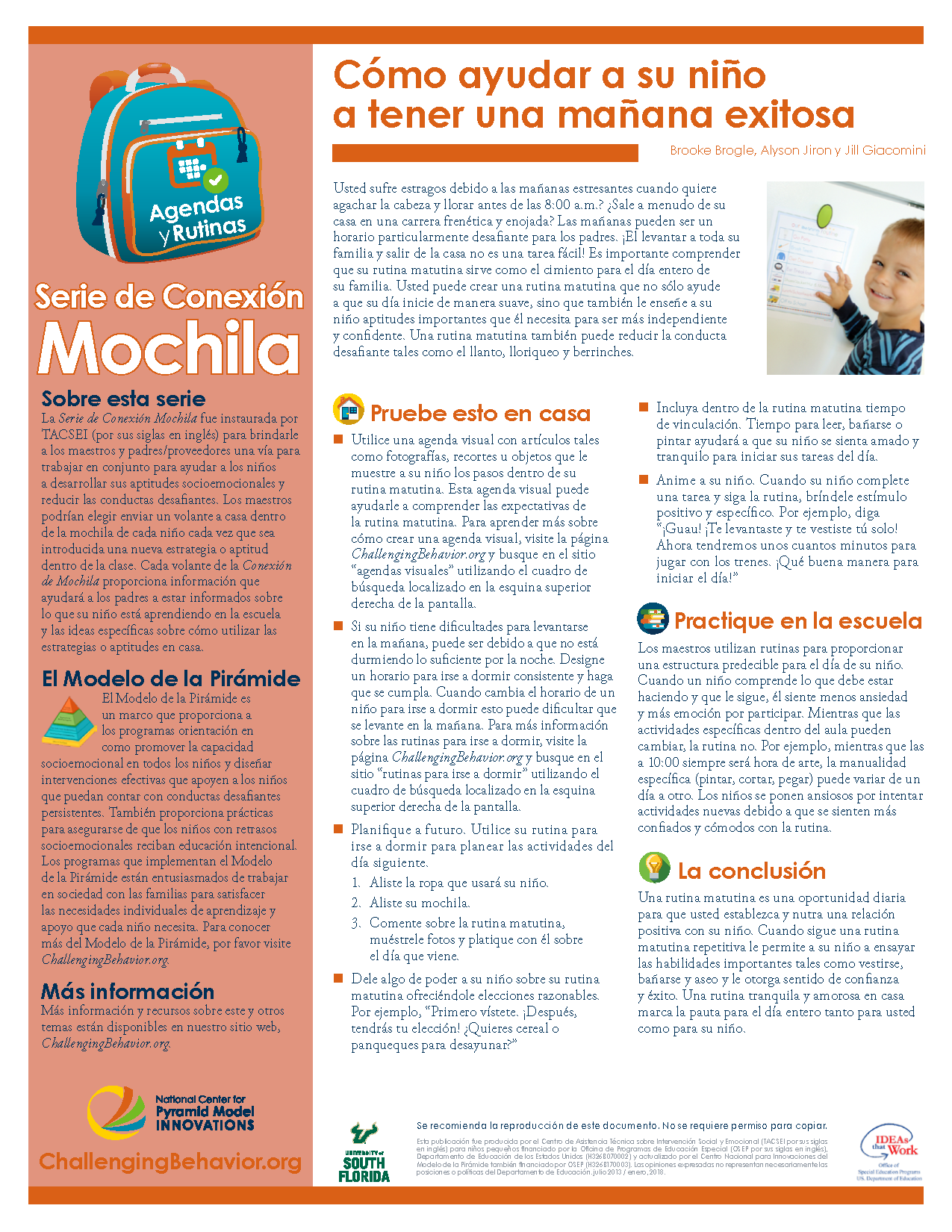
The Backpack Connection Series was created by TACSEI to provide a way for teachers and parents/caregivers to work together to help young children develop social emotional skills and reduce challenging behavior. Teachers may choose to send a handout home in each child’s backpack when a new strategy or skill is introduced to the class.

The Backpack Connection Series was created by TACSEI to provide a way for teachers and parents/caregivers to work together to help young children develop social emotional skills and reduce challenging behavior. Teachers may choose to send a handout home in each child’s backpack when a new strategy or skill is introduced to the class.

The Backpack Connection Series was created by TACSEI to provide a way for teachers and parents/caregivers to work together to help young children develop social emotional skills and reduce challenging behavior. Teachers may choose to send a handout home in each child’s backpack when a new strategy or skill is introduced to the class.

The Backpack Connection Series was created by TACSEI to provide a way for teachers and parents/caregivers to work together to help young children develop social emotional skills and reduce challenging behavior. Teachers may choose to send a handout home in each child’s backpack when a new strategy or skill is introduced to the class.

The Backpack Connection Series was created by TACSEI to provide a way for teachers and parents/caregivers to work together to help young children develop social emotional skills and reduce challenging behavior. Teachers may choose to send a handout home in each child’s backpack when a new strategy or skill is introduced to the class.

The Backpack Connection Series was created by TACSEI to provide a way for teachers and parents/caregivers to work together to help young children develop social emotional skills and reduce challenging behavior. Teachers may choose to send a handout home in each child’s backpack when a new strategy or skill is introduced to the class.

The Backpack Connection Series was created by TACSEI to provide a way for teachers and parents/caregivers to work together to help young children develop social emotional skills and reduce challenging behavior. Teachers may choose to send a handout home in each child’s backpack when a new strategy or skill is introduced to the class.

The Backpack Connection Series was created by TACSEI to provide a way for teachers and parents/caregivers to work together to help young children develop social emotional skills and reduce challenging behavior. Teachers may choose to send a handout home in each child’s backpack when a new strategy or skill is introduced to the class.
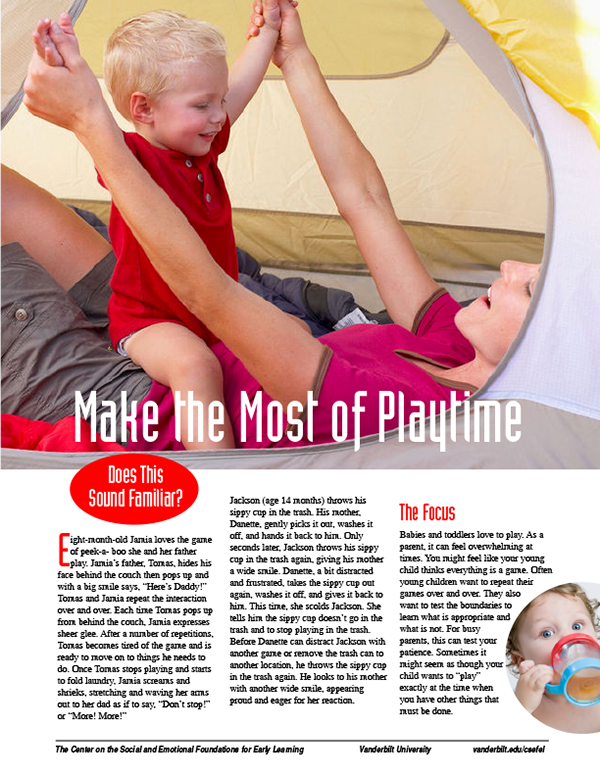
Playtime is special. Playing together with your child is not only fun, but a critical time to support your baby or toddler’s healthy development. Making time for play, especially active play, can also help in reducing your child’s challenging behavior. So what can you do to make the most of your child’s playtime? To answer this question, check out the many tips and ideas for children of varying ages in this fun and useful six-page resource.

Playtime is special. Playing together with your child is not only fun, but a critical time to support your baby or toddler’s healthy development. Making time for play, especially active play, can also help in reducing your child’s challenging behavior. So what can you do to make the most of your child’s playtime? To answer this question, check out the many tips and ideas for children of varying ages in this fun and useful six-page resource.

Many toddlers and young children bite. Developmentally, most toddlers don?t have enough words to express how they are feeling. They primarily rely on sounds and actions to communicate what they are thinking and feeling. Biting is one of the ways toddlers express their needs, desires, or feelings. This handout provides information on why children bite, what to do and what not to do, and when to seek professional help.

Many toddlers and young children bite. Developmentally, most toddlers don?t have enough words to express how they are feeling. They primarily rely on sounds and actions to communicate what they are thinking and feeling. Biting is one of the ways toddlers express their needs, desires, or feelings. This handout provides information on why children bite, what to do and what not to do, and when to seek professional help.

Understanding feelings is an important part of a child’s social emotional development. Babies and toddlers experience feelings just like you do, and know when you are feeling happy or down as well. When you use words to describe emotions, share in their good feelings, and comfort them when they feel sad or overwhelmed, young children are learning important social emotional skills.

Understanding feelings is an important part of a child’s social emotional development. Babies and toddlers experience feelings just like you do, and know when you are feeling happy or down as well. When you use words to describe emotions, share in their good feelings, and comfort them when they feel sad or overwhelmed, young children are learning important social emotional skills.

Young children can learn how to do simple daily self-help activities—they just need to be taught what to do. When teaching a child to do self-care skills, you first need to know what you can typically expect of a young child, your child’s skill level, and how to provide clear and simple instructions about how to do a task. In addition, providing children with ample encouragement that is both positive and specific will help promote their success. The information in this handout will help you understand what you can expect from your preschooler and provides tips for helping your child learn how to become more independent with daily routines.
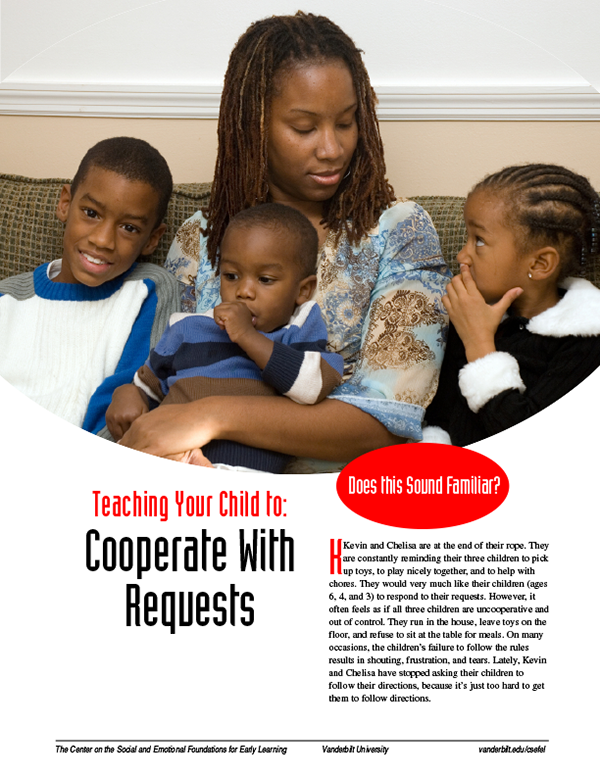
Young children can learn to follow adult expectations, including performing simple chores, if the expectations are developmentally appropriate (meaning they match what can be expected for children at that age) and are taught to the child. This four-page handout provides information on what you might expect from your preschooler and some tips for helping your child learn and follow your requests.

Young children can learn to follow adult expectations, including performing simple chores, if the expectations are developmentally appropriate (meaning they match what can be expected for children at that age) and are taught to the child. This four-page handout provides information on what you might expect from your preschooler and some tips for helping your child learn and follow your requests.

Young children deal with many of the same emotions adults do. Children get angry, sad, frustrated, nervous, happy, or embarrassed, but they often do not have the words to talk about how they are feeling. Instead, they sometimes act out these emotions in very physical and inappropriate ways. This four-page handout describes specific steps and strategies adults can use to help children express themselves in ways that are appropriate.

Young children deal with many of the same emotions adults do. Children get angry, sad, frustrated, nervous, happy, or embarrassed, but they often do not have the words to talk about how they are feeling. Instead, they sometimes act out these emotions in very physical and inappropriate ways. This four-page handout describes specific steps and strategies adults can use to help children express themselves in ways that are appropriate.

Babies and toddlers experience and express thoughts and feelings. Often they communicate their strong feelings through behaviors that adults understand right away. Other times, very young children’s behavior can be confusing or even frustrating to the adults who care for them. Being able to stay calm, make a good guess at what the behavior might mean, and then respond helps children understand that they are powerful communicators. Over the long-term, this helps children learn how to connect with others in ways that are healthy and respectful?a skill they?ll use for life.
Related Resources

Early interventionists can use this form during home visits with caregivers to help them talk through their current daily routines as well as help them to plan out the ways they will embed supports that are responsive to their infant or toddler’s social-emotional development and teach new skills during specific moments in the family’s day.

This practice brief provides prevention strategies to help children with challenging behavior who have been exposed to trauma and strategies for responding to children when they are trauma-activated.

Tip Sheet on various communication strategies for early childhood programs and teachers to communicate with families.

Playtime is special. Playing together with your child is not only fun, but a critical time to support your baby or toddler’s healthy development. Making time for play, especially active play, can also help in reducing your child’s challenging behavior. So what can you do to make the most of your child’s playtime? To answer this question, check out the many tips and ideas for children of varying ages in this fun and useful six-page resource.

Playtime is special. Playing together with your child is not only fun, but a critical time to support your baby or toddler’s healthy development. Making time for play, especially active play, can also help in reducing your child’s challenging behavior. So what can you do to make the most of your child’s playtime? To answer this question, check out the many tips and ideas for children of varying ages in this fun and useful six-page resource.

Many toddlers and young children bite. Developmentally, most toddlers don?t have enough words to express how they are feeling. They primarily rely on sounds and actions to communicate what they are thinking and feeling. Biting is one of the ways toddlers express their needs, desires, or feelings. This handout provides information on why children bite, what to do and what not to do, and when to seek professional help.

Many toddlers and young children bite. Developmentally, most toddlers don?t have enough words to express how they are feeling. They primarily rely on sounds and actions to communicate what they are thinking and feeling. Biting is one of the ways toddlers express their needs, desires, or feelings. This handout provides information on why children bite, what to do and what not to do, and when to seek professional help.

This resource offers guidance on supporting children after stressful events and includes strategies for families and caregivers to create safety and predictability through routines, clear communication, and emotional connection.

This resource provides teachers tools to engage families in promoting positive interactions between toddlers and their friends (or siblings). It includes a teacher’s guide for using the tool, a family handout, and an activity idea that teacher can use to communicate with families about their children’s play activities at home.

This resource provides teachers tools to engage families in promoting positive interactions between toddlers and their friends (or siblings). It includes a teacher’s guide for using the tool, a family handout, and an activity idea that teacher can use to communicate with families about their children’s play activities at home.
The translation of this document was performed by a third party. NCPMI makes no guarantees as to the accuracy of the translation.
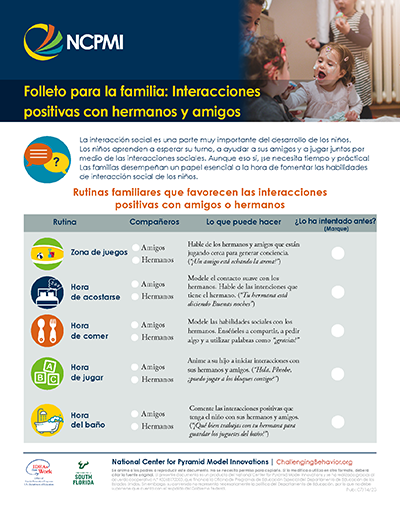
This resource provides teachers tools to engage families in promoting positive interactions between toddlers and their friends (or siblings). It includes a teacher’s guide for using the tool, a family handout, and an activity idea that teacher can use to communicate with families about their children’s play activities at home.
The translation of this document was performed by a third party. NCPMI makes no guarantees as to the accuracy of the translation.

This resource provides teachers tools to build relationships with families. It includes a teacher’s guide for using the tool and two fill-in handouts for the teacher and families.

This guide introduces four resources that promote family engagement in infants’ and toddlers’ social-emotional learning outside the classroom. Included are a teacher’s guide for using the resources and links to the four family engagement resources.

Understanding feelings is an important part of a child’s social emotional development. Babies and toddlers experience feelings just like you do, and know when you are feeling happy or down as well. When you use words to describe emotions, share in their good feelings, and comfort them when they feel sad or overwhelmed, young children are learning important social emotional skills.

Understanding feelings is an important part of a child’s social emotional development. Babies and toddlers experience feelings just like you do, and know when you are feeling happy or down as well. When you use words to describe emotions, share in their good feelings, and comfort them when they feel sad or overwhelmed, young children are learning important social emotional skills.

Young children can learn how to do simple daily self-help activities—they just need to be taught what to do. When teaching a child to do self-care skills, you first need to know what you can typically expect of a young child, your child’s skill level, and how to provide clear and simple instructions about how to do a task. In addition, providing children with ample encouragement that is both positive and specific will help promote their success. The information in this handout will help you understand what you can expect from your preschooler and provides tips for helping your child learn how to become more independent with daily routines.

Caregivers can use the strategies in the infographic to provide infants with predictability in their day, and safety in relationships- all to support healthy attachment. Infants rely on the adults in their lives to read their cues, and help them to regulate as they adapt to their world. Responsive and positive interactions between infants and their caregivers help to build a strong attachment relationship. Positive attachment relationships support healthy brain development, and set babies up for success to learn about their emotions and build relationships as they grow into toddlers and preschoolers.

Caregivers can use the strategies in the infographic to provide infants with predictability in their day, and safety in relationships- all to support healthy attachment. Infants rely on the adults in their lives to read their cues, and help them to regulate as they adapt to their world. Responsive and positive interactions between infants and their caregivers help to build a strong attachment relationship. Positive attachment relationships support healthy brain development, and set babies up for success to learn about their emotions and build relationships as they grow into toddlers and preschoolers.

Toddlers experience big emotions as they learn to make meaning of their world and communicate their needs. Toddlers look to their primary caregivers to let them what they are experiencing is okay. Caregivers can use the strategies included in this infographic to provide toddlers with predictability in their day, safety in relationships, meaning to their experiences and emotions, and begin to build their problem-solving skills.
The translation of this document was performed by a third party. NCPMI makes no guarantees as to the accuracy of the translation.

Toddlers experience big emotions as they learn to make meaning of their world and communicate their needs. Toddlers look to their primary caregivers to let them what they are experiencing is okay. Caregivers can use the strategies included in this infographic to provide toddlers with predictability in their day, safety in relationships, meaning to their experiences and emotions, and begin to build their problem-solving skills.

Toddlers experience big emotions as they learn to make meaning of their world and communicate their needs. Toddlers look to their primary caregivers to let them what they are experiencing is okay. Caregivers can use the strategies included in this infographic to provide toddlers with predictability in their day, safety in relationships, meaning to their experiences and emotions, and begin to build their problem-solving skills.

Toddlers experience big emotions as they learn to make meaning of their world and communicate their needs. Toddlers look to their primary caregivers to let them what they are experiencing is okay. Caregivers can use the strategies included in this infographic to provide toddlers with predictability in their day, safety in relationships, meaning to their experiences and emotions, and begin to build their problem-solving skills.
The translation of this document was performed by a third party. NCPMI makes no guarantees as to the accuracy of the translation.

Toddlers experience big emotions as they learn to make meaning of their world and communicate their needs. Toddlers look to their primary caregivers to let them what they are experiencing is okay. Caregivers can use the strategies included in this infographic to provide toddlers with predictability in their day, safety in relationships, meaning to their experiences and emotions, and begin to build their problem-solving skills.
The translation of this document was performed by a third party. NCPMI makes no guarantees as to the accuracy of the translation.

Babies and toddlers experience and express thoughts and feelings. Often they communicate their strong feelings through behaviors that adults understand right away. Other times, very young children’s behavior can be confusing or even frustrating to the adults who care for them. Being able to stay calm, make a good guess at what the behavior might mean, and then respond helps children understand that they are powerful communicators. Over the long-term, this helps children learn how to connect with others in ways that are healthy and respectful?a skill they?ll use for life.
Children and families have a smoother day when children know what to expect. The resources below provide families with strategies for setting up schedules, routines, and smooth transitions.

This handout helps preschool teachers to develop balanced daily schedules including considerations such as Activity Level, Child/Adult Directedness, and Group Size throughout the day.

This handout helps preschool teachers to identify routines for activities occurring in the classroom. The template is designed so teachers can think through each step of the routine, how to teach the steps, and how to individualize them. Use the example for guidance.

This infographic is the first in a series of tips for families. Early care and education and family support programs are encouraged to download the infographic to use in their social media to families or repost on their web site.
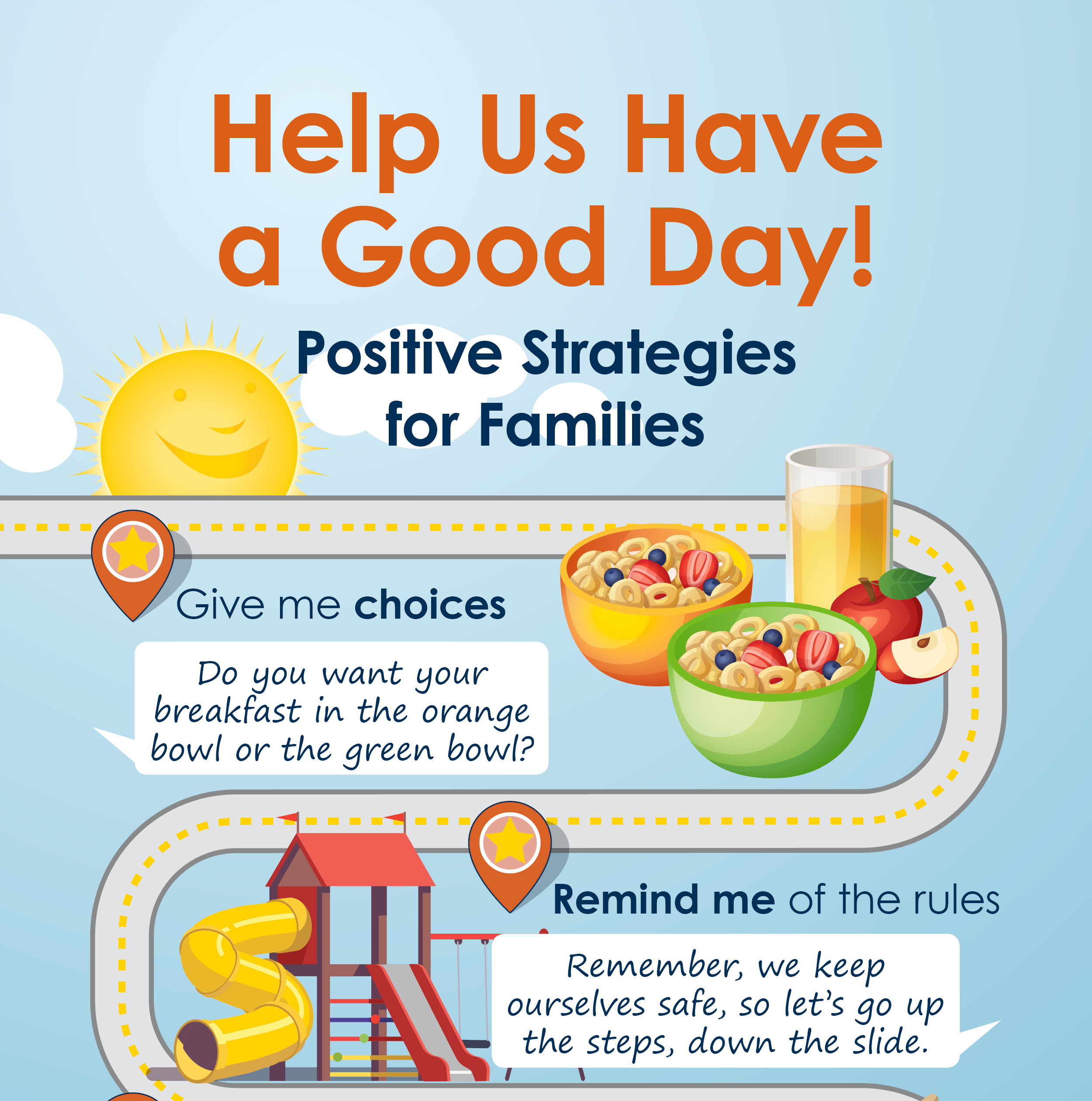
This infographic is the first in a series of tips for families. Early care and education and family support programs are encouraged to download the infographic to use in their social media to families or repost on their web site.

This infographic is the first in a series of tips for families. Early care and education and family support programs are encouraged to download the infographic to use in their social media to families or repost on their web site.

This infographic is the first in a series of tips for families. Early care and education and family support programs are encouraged to download the infographic to use in their social media to families or repost on their web site.

This infographic is the first in a series of tips for families. Early care and education and family support programs are encouraged to download the infographic to use in their social media to families or repost on their web site.

This infographic is the first in a series of tips for families. Early care and education and family support programs are encouraged to download the infographic to use in their social media to families or repost on their web site.

This infographic is the first in a series of tips for families. Early care and education and family support programs are encouraged to download the infographic to use in their social media to families or repost on their web site.

This tip sheet provides families with strategies to help children predict what is coming next which helps make
transitions smoother.

This tip sheet provides families with strategies to help children predict what is coming next which helps make transitions smoother.

The Backpack Connection Series was created by TACSEI to provide a way for teachers and parents/caregivers to work together to help young children develop social emotional skills and reduce challenging behavior. Teachers may choose to send a handout home in each child’s backpack when a new strategy or skill is introduced to the class.

The Backpack Connection Series was created by TACSEI to provide a way for teachers and parents/caregivers to work together to help young children develop social emotional skills and reduce challenging behavior. Teachers may choose to send a handout home in each child’s backpack when a new strategy or skill is introduced to the class.

The Backpack Connection Series was created by TACSEI to provide a way for teachers and parents/caregivers to work together to help young children develop social emotional skills and reduce challenging behavior. Teachers may choose to send a handout home in each child’s backpack when a new strategy or skill is introduced to the class.

The Backpack Connection Series was created by TACSEI to provide a way for teachers and parents/caregivers to work together to help young children develop social emotional skills and reduce challenging behavior. Teachers may choose to send a handout home in each child’s backpack when a new strategy or skill is introduced to the class.

The Backpack Connection Series was created by TACSEI to provide a way for teachers and parents/caregivers to work together to help young children develop social emotional skills and reduce challenging behavior. Teachers may choose to send a handout home in each child’s backpack when a new strategy or skill is introduced to the class.

The Backpack Connection Series was created by TACSEI to provide a way for teachers and parents/caregivers to work together to help young children develop social emotional skills and reduce challenging behavior. Teachers may choose to send a handout home in each child’s backpack when a new strategy or skill is introduced to the class.

The Backpack Connection Series was created by TACSEI to provide a way for teachers and parents/caregivers to work together to help young children develop social emotional skills and reduce challenging behavior. Teachers may choose to send a handout home in each child’s backpack when a new strategy or skill is introduced to the class.

The Backpack Connection Series was created by TACSEI to provide a way for teachers and parents/caregivers to work together to help young children develop social emotional skills and reduce challenging behavior. Teachers may choose to send a handout home in each child’s backpack when a new strategy or skill is introduced to the class.

The Backpack Connection Series was created by TACSEI to provide a way for teachers and parents/caregivers to work together to help young children develop social emotional skills and reduce challenging behavior. Teachers may choose to send a handout home in each child’s backpack when a new strategy or skill is introduced to the class.

The Backpack Connection Series was created by TACSEI to provide a way for teachers and parents/caregivers to work together to help young children develop social emotional skills and reduce challenging behavior. Teachers may choose to send a handout home in each child’s backpack when a new strategy or skill is introduced to the class.

The Backpack Connection Series was created by TACSEI to provide a way for teachers and parents/caregivers to work together to help young children develop social emotional skills and reduce challenging behavior. Teachers may choose to send a handout home in each child’s backpack when a new strategy or skill is introduced to the class.

Young children can learn how to do simple daily self-help activities—they just need to be taught what to do. When teaching a child to do self-care skills, you first need to know what you can typically expect of a young child, your child’s skill level, and how to provide clear and simple instructions about how to do a task. In addition, providing children with ample encouragement that is both positive and specific will help promote their success. The information in this handout will help you understand what you can expect from your preschooler and provides tips for helping your child learn how to become more independent with daily routines.

Teachers and parents can use these strategies and visual cards to help young children transition smoothly between activities.


Guide to using visuals and schedules for supporting children. Includes templates for visual cards and first/then boards.
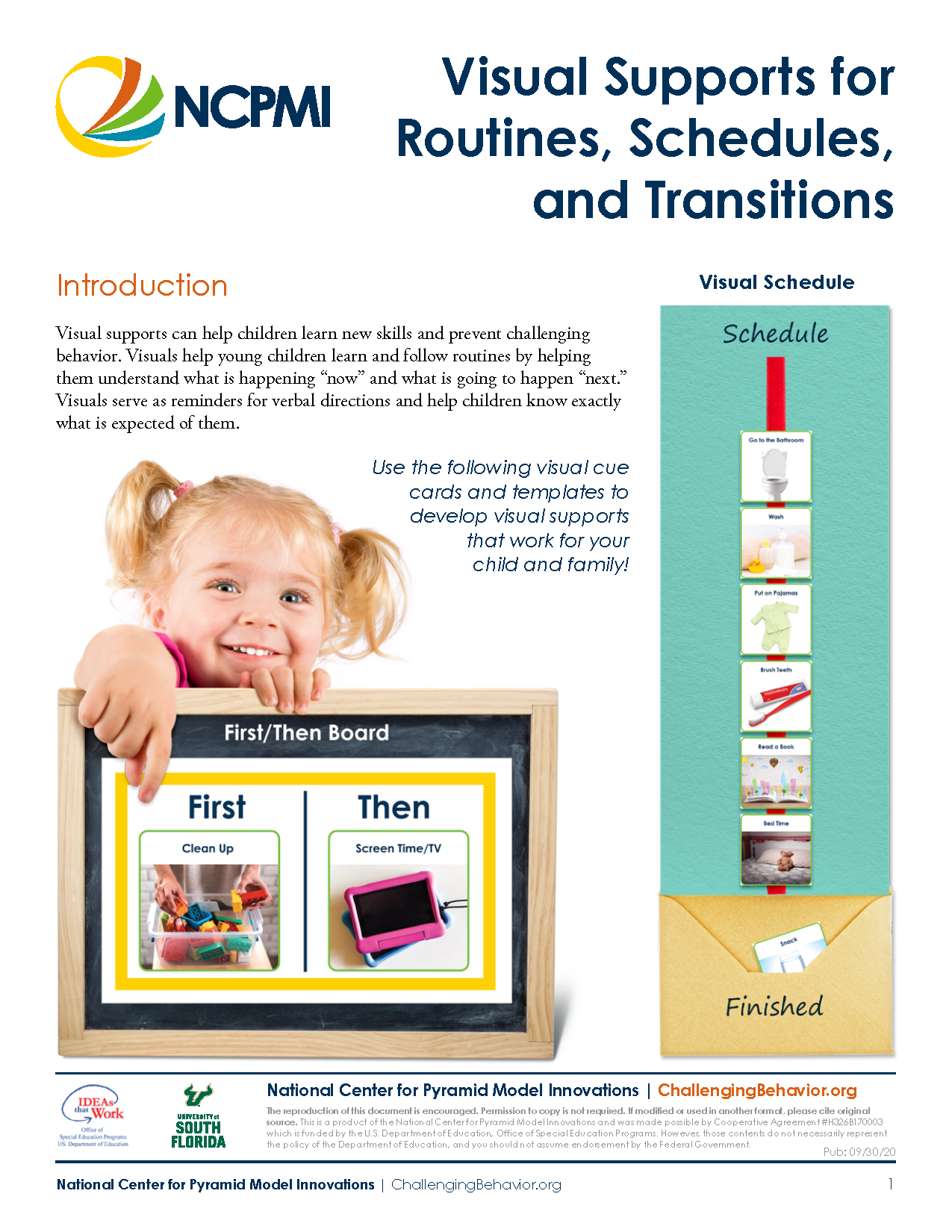
This resource provides families with instructions and resources to develop and use visual schedules, routine cards, and first/then boards.

This resource provides families with instructions and resources to develop and use visual schedules, routine cards, and first/then boards.

This webinar introduced 10 dimensions of belonging and explores how Pyramid Model programs, providers, and policies can progress beyond family engagement. Presenters will share practical examples for designing and cultivating environments and experiences that celebrate families’ strengths and value their essential role in the community, fostering a meaningful quality of life for all.

Have you encountered families who feel that there is no hope to change their child’s behavior?
The reduction in negative thinking and interpretation of events by parents has been documented as influencing parent behavior change, including enhanced implementation fidelity of behavior support strategies, resulting in improved child and family outcomes. Learn about the Positive Family Intervention research project and the cognitive behavior skill training procedures, also known as optimism training, that were utilized to teach parents how to identify situations prompting negative self-talk, specific beliefs that create barriers to intervention, the consequences of these beliefs, and the practice of using disputation and substitution. An application of optimism training will be shared that demonstrates how the reduction of parent pessimism helped to promote parent confidence, improved parent and child efficacy, and influenced the successful delivery and fidelity of PBS interventions for their child at home. Future considerations of adapting optimism training for use within collaborative teams to foster increased teacher confidence, persistence, and implementation fidelity of behavior supports for young children in school settings will also be proposed for discussion.

Is the Pyramid Model a framework that can be used in programs serving indigenous children and their families? What changes need to be made to ensure a fit with the culture of tribes and families served by those programs? Join us for a discussion from two programs, Cook Inlet Native Head Start in Alaska and Zaasijiwan Head Start in Wisconsin, to learn more about their Pyramid Model implementation and outcomes.

Pyramid Model Classroom Coach Raquel Lima describes children’s positive outcomes after implementing the Pyramid Model.

Pyramid Model Classroom Coach Raquel Lima describes children’s positive outcomes after implementing the Pyramid Model.

Are you providing early intervention or preschool services using distance technology? Do you have questions about how you can support families as they help their children with learning activities or conducting intervention within routines? NCPMI faculty share ideas on checking in with families, how to respond to difficult questions, and resources that might be shared.

This webinar will provide an overview of the updated Positive Solutions for Families (PSF) materials. Panelists include family members who have participated in PSF workshops before becoming experienced PSF facilitators themselves. Join us as panelists share their experiences using the new materials implementing Positive Solutions for Families workshops. They will share their experiences from a family perspective offering a holistic viewpoint of the PSF experience.

Early interventionists can use this form during home visits with caregivers to help them talk through their current daily routines as well as help them to plan out the ways they will embed supports that are responsive to their infant or toddler’s social-emotional development and teach new skills during specific moments in the family’s day.

Part guide and part planning tool, this resource, created in collaboration with the TIES Center, helps early childhood teams and families partner to build more inclusive programs and environments where every family feels a sense of belonging. Centered on the experiences of families, it outlines ten dimensions of belonging, offers prompts for shared reflection, and provides a planning tool to move from insight to action. Designed for practitioners, specialists, and program leaders supporting children and their families from birth to age eight, this tool can be used in family meetings, team discussions, and/or leadership planning to celebrate what’s working, identify areas for growth, and plan next steps together in partnership with families.

Leadership teams can use this activity to get staff input on the program expectations.

Leadership teams can use this handout to get family input on the program expectations.

Leadership teams can use this handout to get family input on the program expectations.

This article highlighting ways your Pyramid Model Leadership Team can partner with families.

Family members were surveyed about their family’s experience at their child’s program implementing the Pyramid Model. This infographic shows the percent of families that agreed or strongly agreed with the statements reflecting family and program partnerships, and what their child has learned.

Empowering families to be active and valued participants in the Individualized Positive Behavior Support Plan (IPBS) is foundational to Pyramid Model implementation. This set of tips and strategies helps families ensure their values, assets, perspectives, and preferences are included in individualized support for their children.
Last Updated: 10/01/2024 ADA updates
Created: 01/11/2024

Helping your child during the pandemic provides families with a few strategies to help their child cope during the pandemic. Programs and professionals are encouraged to post this resource on their web sites or share through social media.
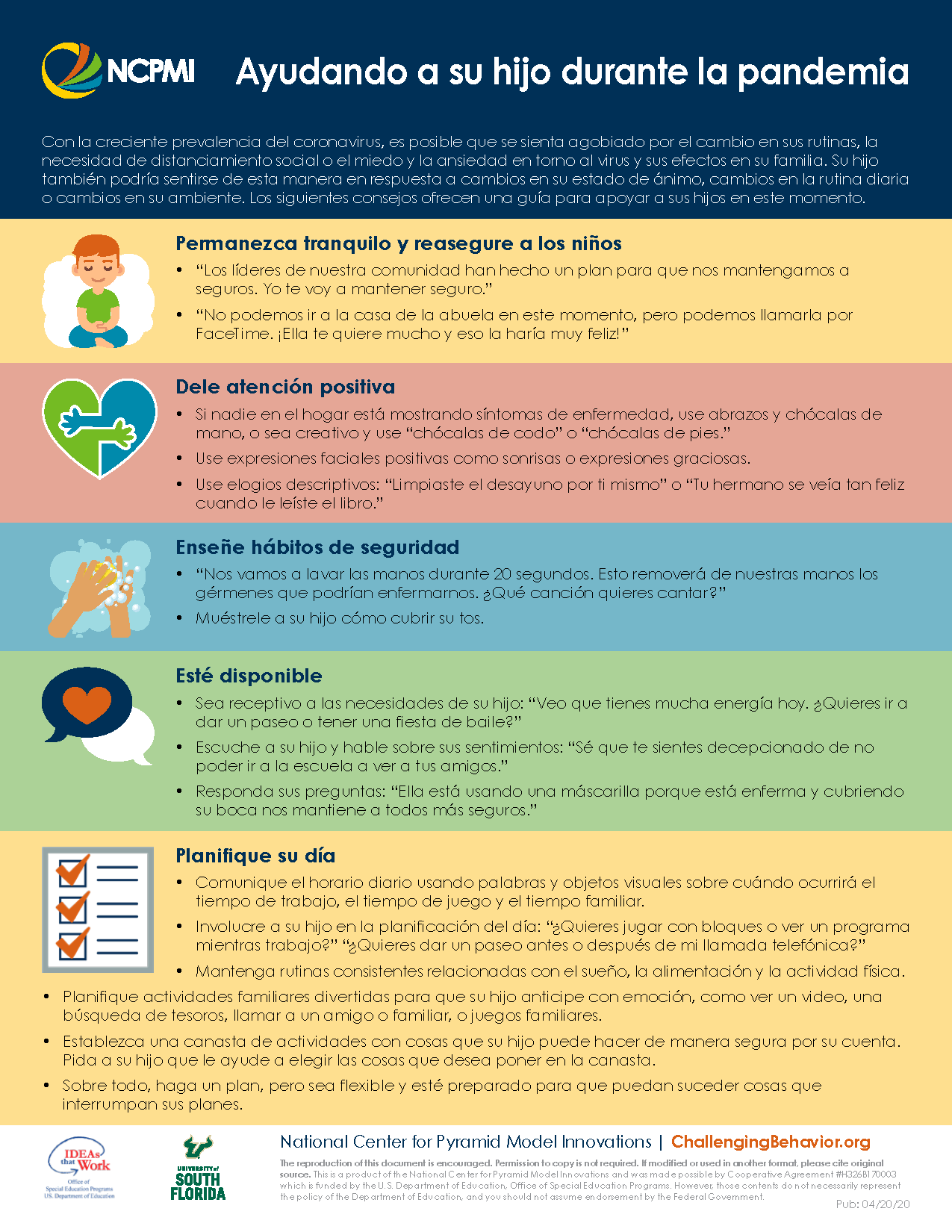
Helping your child during the pandemic provides families with a few strategies to help their child cope during the pandemic. Programs and professionals are encouraged to post this resource on their web sites or share through social media.


Programs can share this handout with families to inform them of their Pyramid Model implementation efforts.

Programs can share this handout with families to inform them of their Pyramid Model implementation efforts.

Adding family members to your Leadership Team? Make them?feel welcome with this family friendly handout that explains the leadership team and provides family members ideas on how to partner with the leadership team. This resource also makes a great family recruitment tool!

Adding family members to your Leadership Team? Make them?feel welcome with this family friendly handout that explains the leadership team and provides family members ideas on how to partner with the leadership team. This resource also makes a great family recruitment tool!

Grades stat from the early years to the ea S Tlicy-statement-on-family-engagement.pdf

Summary stat from the early years to the early grades – executi S Tlicy-statement-on-family-engagement-executive-summary.pdf

Family brochure on positive solution strategies.

Family brochure on positive solution strategies in Spanish

The Positive Solutions Family Routine Guide is used by parents and caregivers of children ages 2-5 years in developing an intervention plan for children who are using challenging behavior. The Guide gives suggestions for prevent, teach, and response strategies, organized by the function of the challenging behavior, within common family activities and routines. The guide is part of the Positive Solutions for Families workshop series.

The Positive Solutions Family Routine Guide is used by parents and caregivers of children ages 2-5 years in developing an intervention plan for children who are using challenging behavior. The Guide gives suggestions for prevent, teach, and response strategies, organized by the function of the challenging behavior, within common family activities and routines. The guide is part of the Positive Solutions for Families workshop series.

This resource collection offers information and materials for programs to use as they authentically partner with families to implement the Pyramid Model. These resources ensure that each family’s “voice and choice” is considered in the planning, development, and evaluation of Pyramid Model activities, programs, and systems.
Last Updated: 10/01/2024 ADA updates
Created: 09/08/2023

This resource provides sample survey items for programs to understand the experiences and perceptions of families. The survey items consider both classroom and program-wide Pyramid Model practices.

Eight strategies for including families in the development and implementation of a behavior support plan.

This set of tips and strategies helps practitioners navigate sensitive or difficult conversations with families. Guidance includes ideas for strengthening relationships with families using the 4Rs: Recognize, Reflect, Regulate, and Repair.

Supporting Behavior Through Connection is a practical resource for families and early childhood practitioners that shifts the focus from compliance to connection. It offers simple, relationship-centered strategies to respond to challenging behavior in ways that help children feel safe, valued, and supported. The resource describes three practices, including examples and prompts, that can be used in everyday routines to build trust and connection with children.

Many early childhood educators and families of young children have been launched into the world of online learning in 2020. This resource provides a few tips from parents for parents on how to support children and yourself during online learning experiences.

Across the country, families and educators are examining issues of racism and equity. This guide provides information about how young children perceive race and suggestions for how to talk about race with young children.

Across the country, families and educators are examining issues of racism and equity. This guide provides information about how young children perceive race and suggestions for how to talk about race with young children.

Tips for helping your child during the pandemic provides families with suggestions and resources for helping their child cope with stress, changes, and staying at home.

Tips for helping your child during the pandemic provides families with suggestions and resources for helping their child cope with stress, changes, and staying at home.

This tipsheet includes suggestions and resources to help you take care of yourself so you can support your child.

This tipsheet includes suggestions and resources to help you take care of yourself so you can support your child.


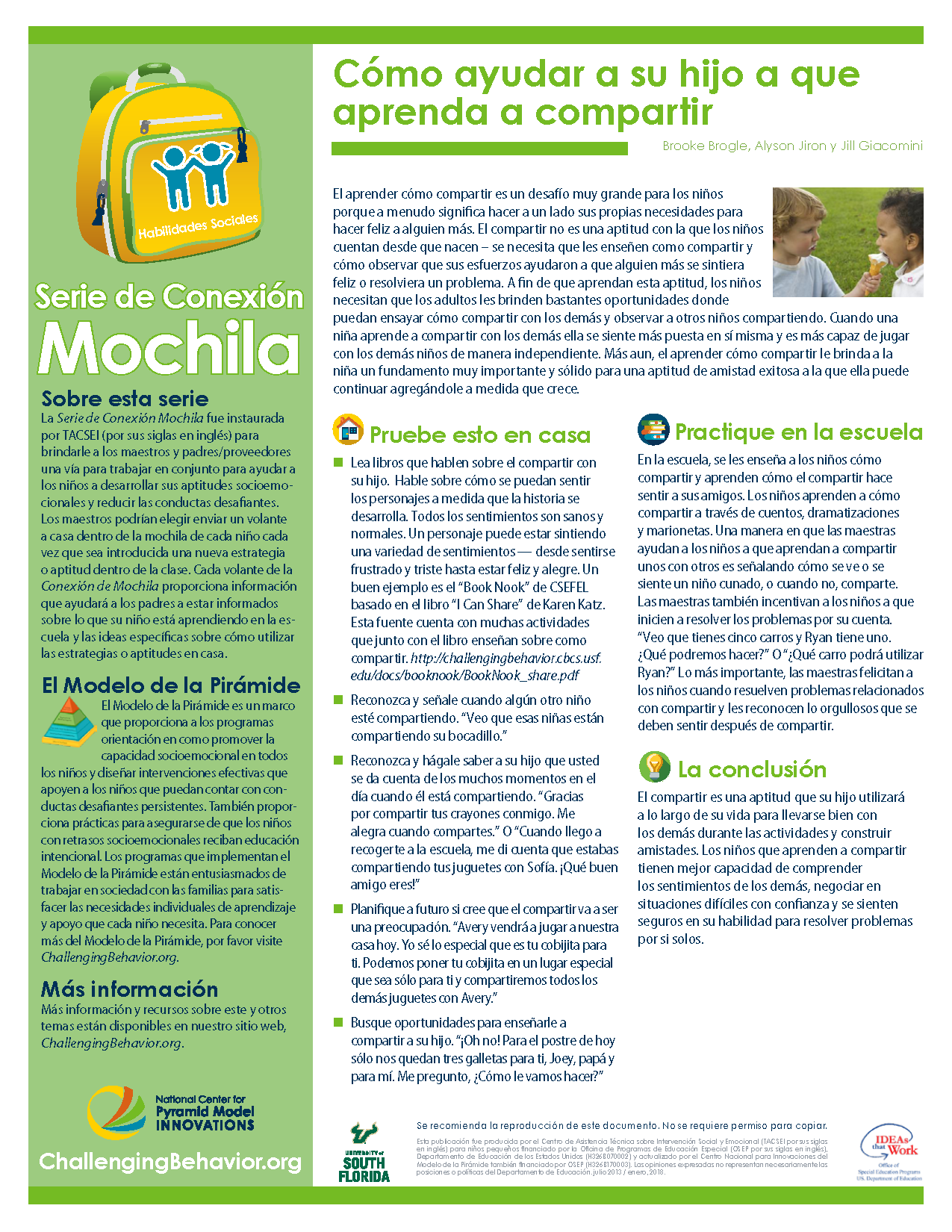








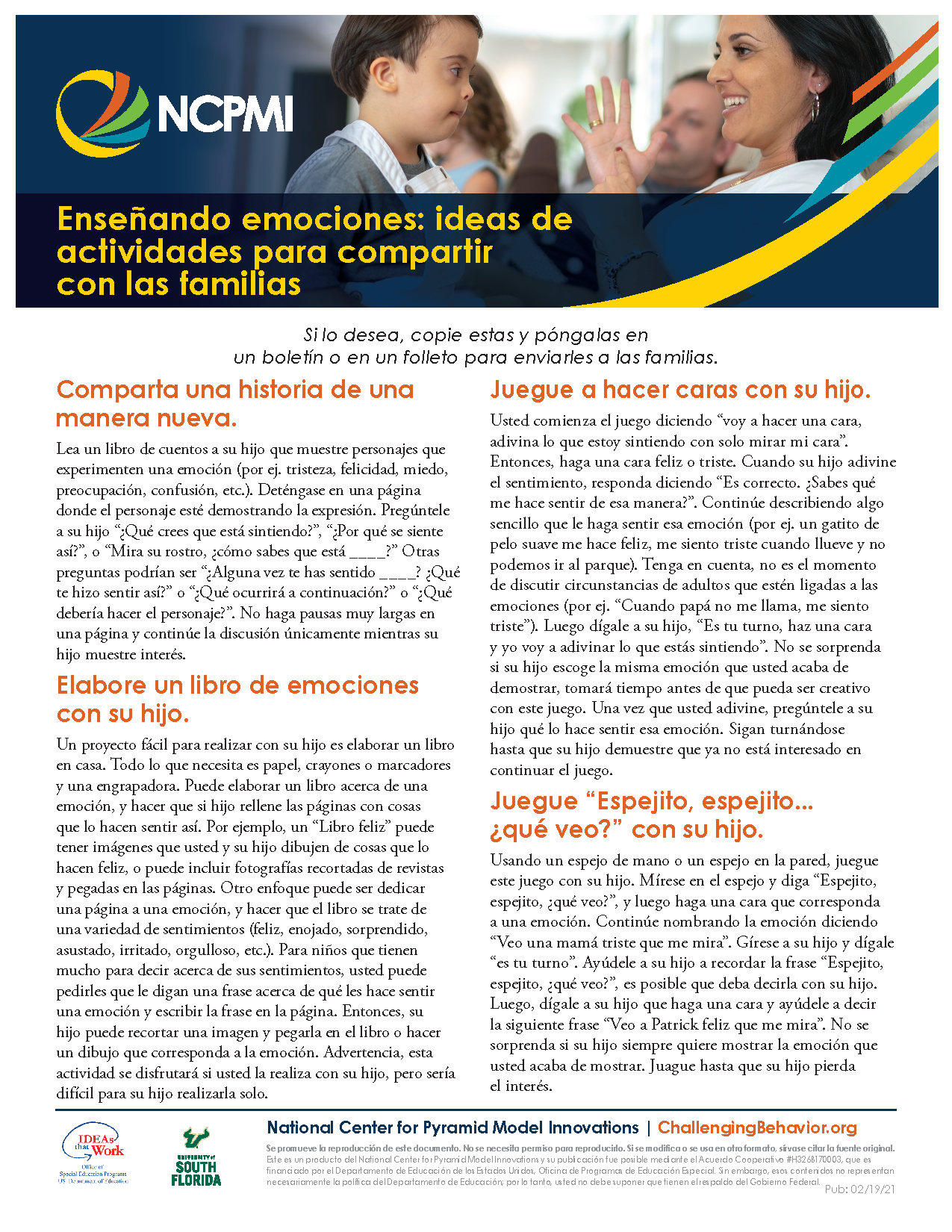




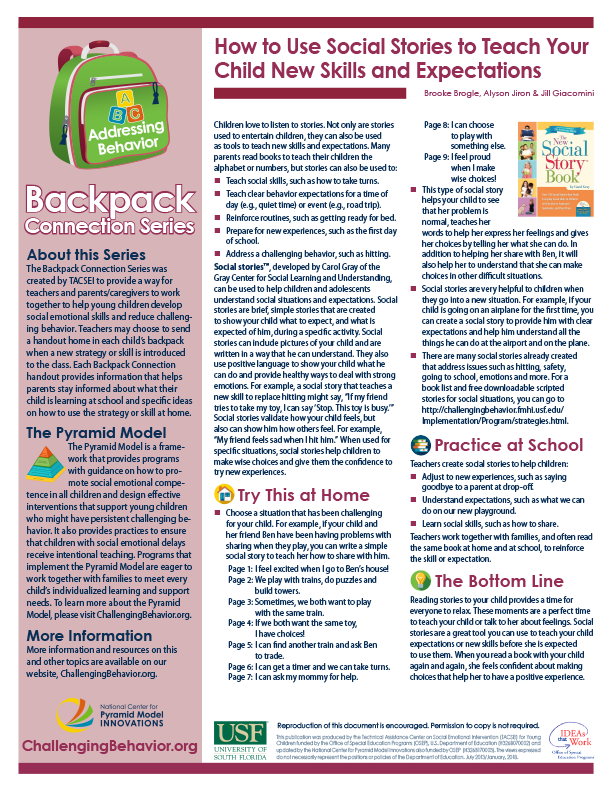
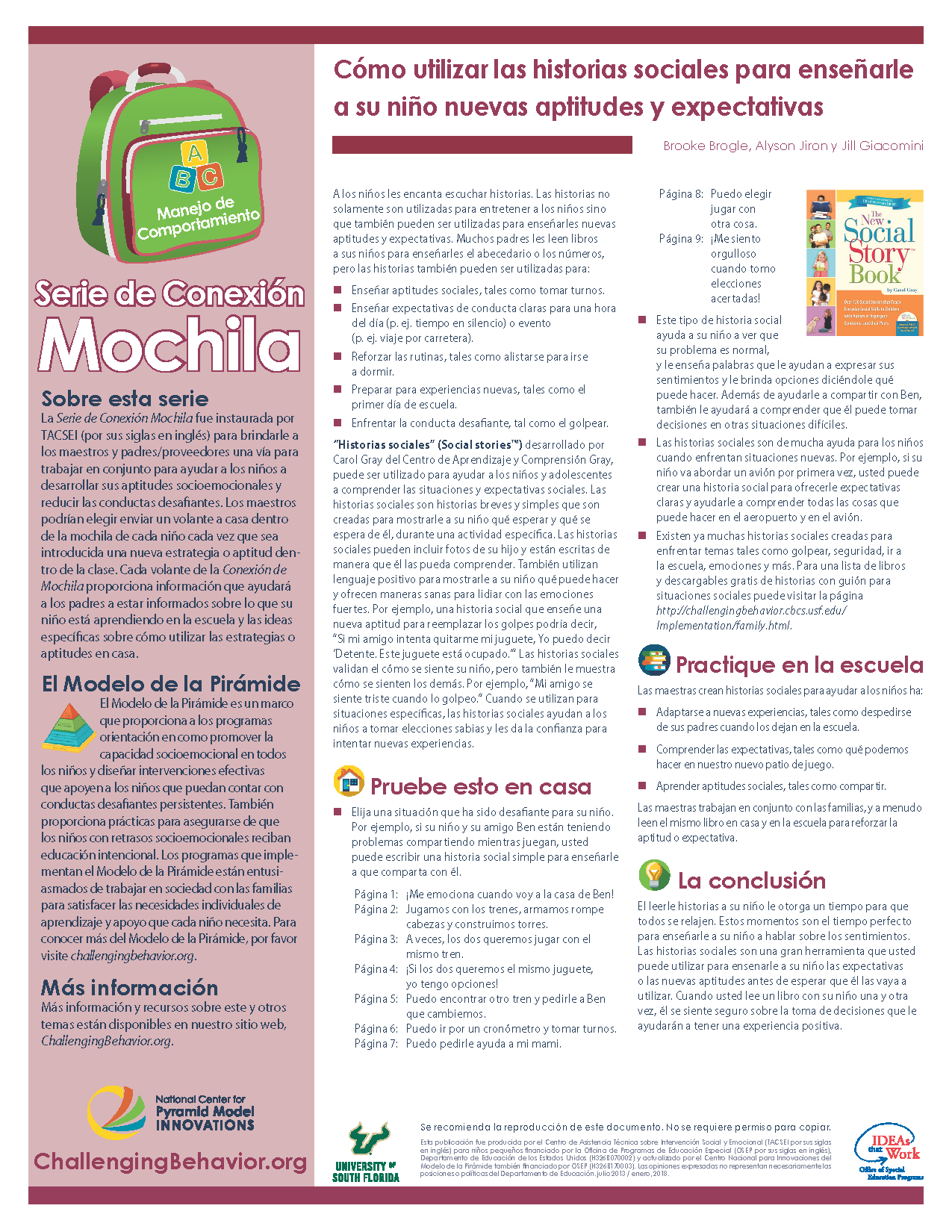



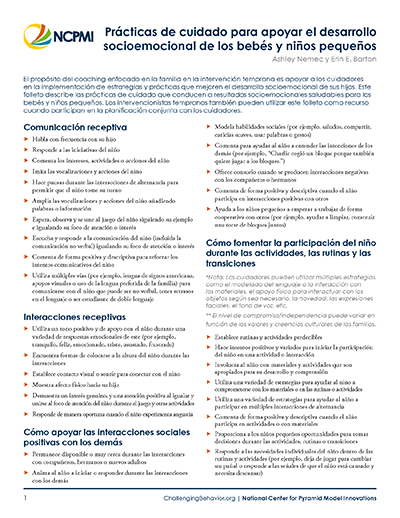




Link to this accordion
Sample poster showing how a family may use visuals to teach family rules.
Sample poster showing how a family may use visuals to teach family rules.
The Backpack Connection Series was created by TACSEI to provide a way for teachers and parents/caregivers to work together to help young children develop social emotional skills and reduce challenging behavior. Teachers may choose to send a handout home in each child’s backpack when a new strategy or skill is introduced to the class.
This tipsheet includes suggestions on how to develop and teach family rules. A template is included for families to create a rules poster with their child.
This tipsheet includes suggestions on how to develop and teach family rules. A template is included for families to create a rules poster with their child.